ForgeSolar Help
Guidance and information on using ForgeSolar analysis tools
These help pages include documentation and guidance on the ForgeSolar tools. This includes detailed descriptions of the editor, analysis methodology and results. ForgeSolar was built with the Solar Glare Hazard Analysis Tool technology (SGHAT), licensed from Sandia National Laboratories. Portions of the Help content is taken from the SGHAT User's and Technical Manuals.
Introduction
With growing numbers of solar energy installations throughout the United States, glare from photovoltaic (PV) arrays has received increased attention as a real hazard for pilots, air-traffic control personnel, motorists, and others. The ForgeSolar suite of tools provide a quantified assessment of:
- when and where glare will occur throughout the year for a prescribed solar installation
- potential effects on the human eye at locations where glare occurs, and
- annual energy production from the PV system so that alternative designs can be compared to maximize energy production while mitigating the impacts of glare
ForgeSolar employs an interactive Google map where the user can quickly locate a site, draw an outline of the proposed PV array(s), and specify observer locations or paths. Latitude, longitude, and elevation are automatically queried from Google, providing necessary information for sun position and vector calculations. Additional information regarding the orientation and tilt of the PV panels, reflectance, environment, and ocular factors are entered by the user.
If glare is found, the tool calculates the retinal irradiance and subtended angle (size/distance) of the glare source to predict potential ocular hazards ranging from temporary after-image to retinal burn. The results are presented in a simple, easy-to-interpret plot that specifies when glare will occur throughout the year, with color codes indicating the potential ocular hazard. The tool can also predict relative energy production while evaluating alternative designs, layouts, and locations to identify configurations that maximize energy production while mitigating the impacts of glare.
ForgeSolar currently includes two tools for glare analysis, which are both accessed via the editor:
- GlareGauge - annual glare hazard analysis of PV arrays and receptors
- GlaReduce - optimization analysis of a single PV array over a range of module configurations (tilts and orientations)
For questions or feedback on Help content, please contact us.
Demonstration Video
This video provides a walk-through of a demo PV glare analysis. Watch as we evaluate an imaginary photovoltaic installation for potential solar glare reflections. We'll set up the PV system in the editor and model nearby receptors, including an airport. We'll also conduct a glare optimization to assess alternative module tilts and orientations.
Site Requirements
ForgeSolar tools are accessible directly on the website. No other downloads or installations are necessary. ForgeSolar is built and optimized for the following browsers:
ForgeSolar also utilizes email to send notifications. Please ensure that the ForgeSolar.com and sendgrid.com domains are whitelisted by your email filter/firewall.
Fundamentals
Background and theory regarding solar glare and regulatory policies
About Glint & Glare
Glint is typically defined as a momentary flash of bright light, often caused by a reflection off a moving source. A typical example of glint is a momentary solar reflection from a moving car. Glare is defined as a continuous source of bright light. Glare is generally associated with stationary objects, which, due to the slow relative movement of the sun, reflect sunlight for a longer duration.
The difference between glint and glare is duration. Industry-standard glare analysis tools evaluate the occurrence of glare on a minute-by-minute basis; accordingly, they generally refer to solar hazards as 'glare'.
The ocular impact of solar glare is quantified into three categories (Ho, 2011):- Green - low potential to cause after-image (flash blindness)
- Yellow - potential to cause temporary after-image
- Red - potential to cause retinal burn (permanent eye damage)
These categories assume a typical blink response in the observer. Note that retinal burn is typically not possible for PV glare since PV modules do not focus reflected sunlight.
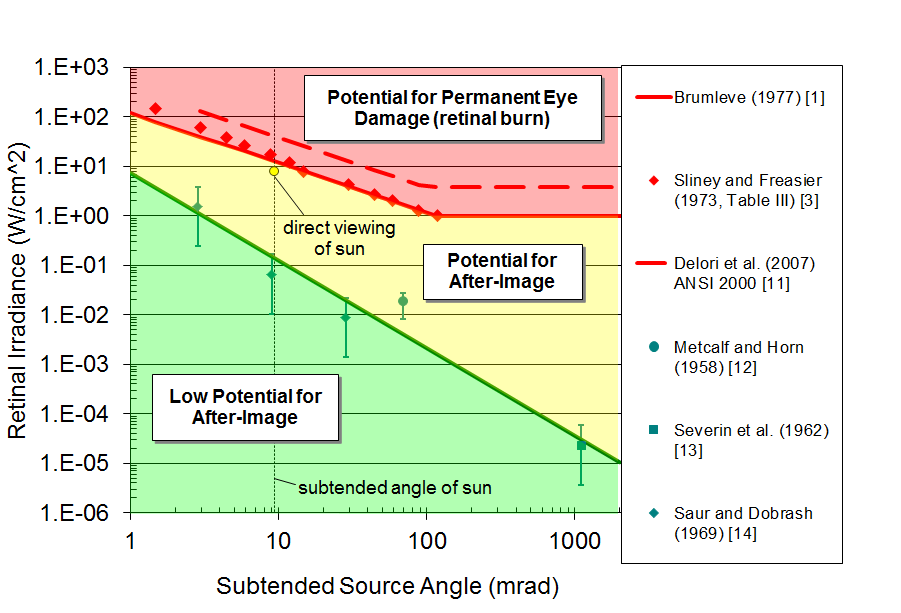
(Ho, 2011)
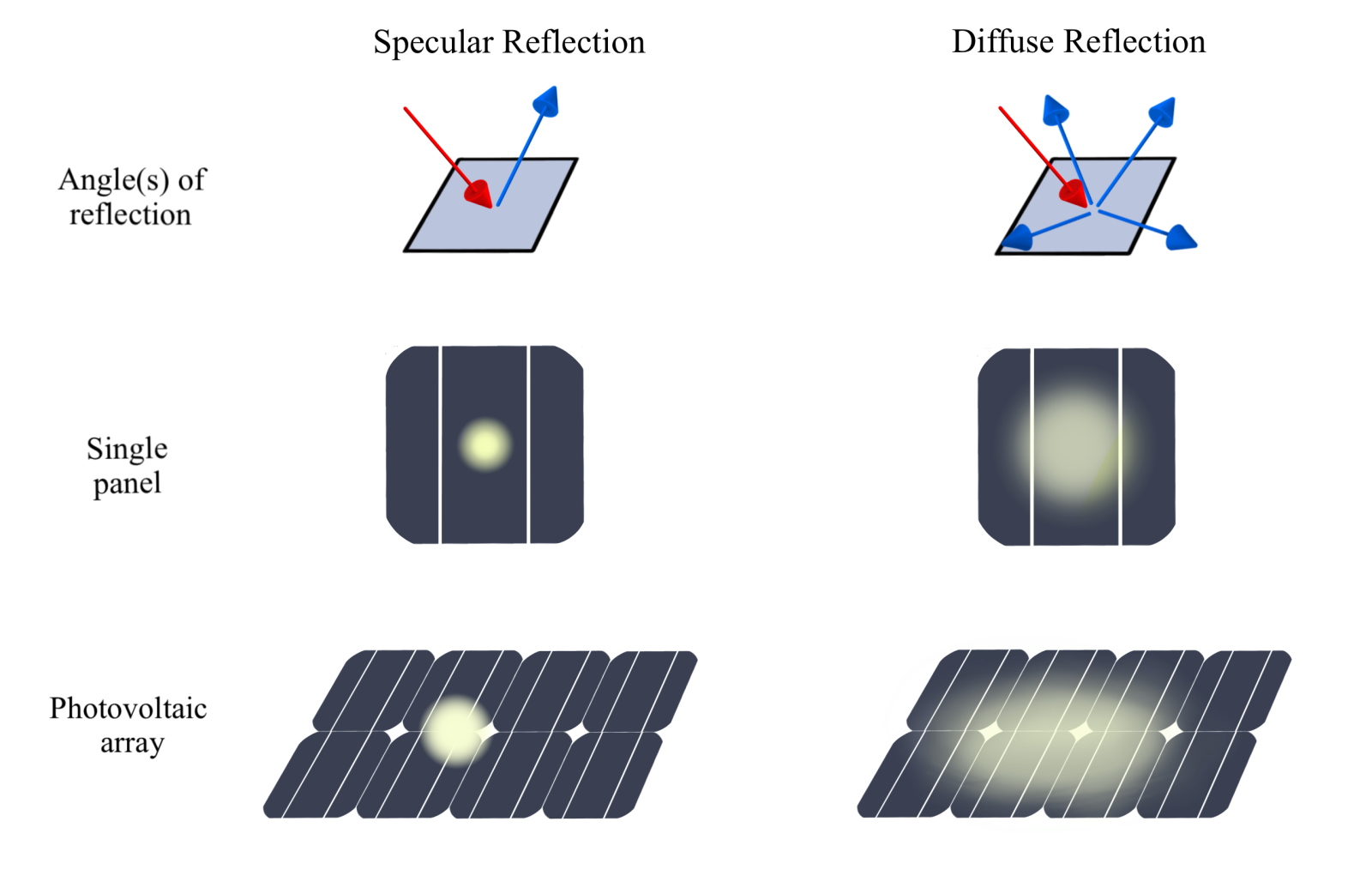
The ocular impact of glare is visualized with the Glare Hazard Plot. This chart displays the ocular impact as a function of glare subtended source angle and retinal irradiance. Each minute of glare is displayed on the chart as a small circle in its respective hazard zone. For convenience, a reference point is provided which illustrates the hazard from viewing the sun without filtering, i.e. staring at the sun. Each plot includes predicted glare for one PV array and one receptor.
About Reflectivity
Reflections from PV panels may impair observers. Studies have found that 7 W/m2 is enough to cause an after-image lasting 4 to 12 seconds (Ho, 2009). This represents a reflection of only 1-2% of typical solar irradiance (incoming sunlight) for a given location, which typically ranges between 800-1000 W/m2.
A key factor of reflectance is the position of PV modules relative to the sun. A panel that absorbs 90% of direct sunlight may reflect up to 60% when not directly facing the sun. This situation is common for low-tilt panels during sunset and sunrise (Yellowhair, 2015). The oft-repeated claim that PV panels reflect less than 5% of sunlight only holds true when the panels directly face the sun. For fixed-mount panels, this claim only applies during a few minutes of the day, at most.
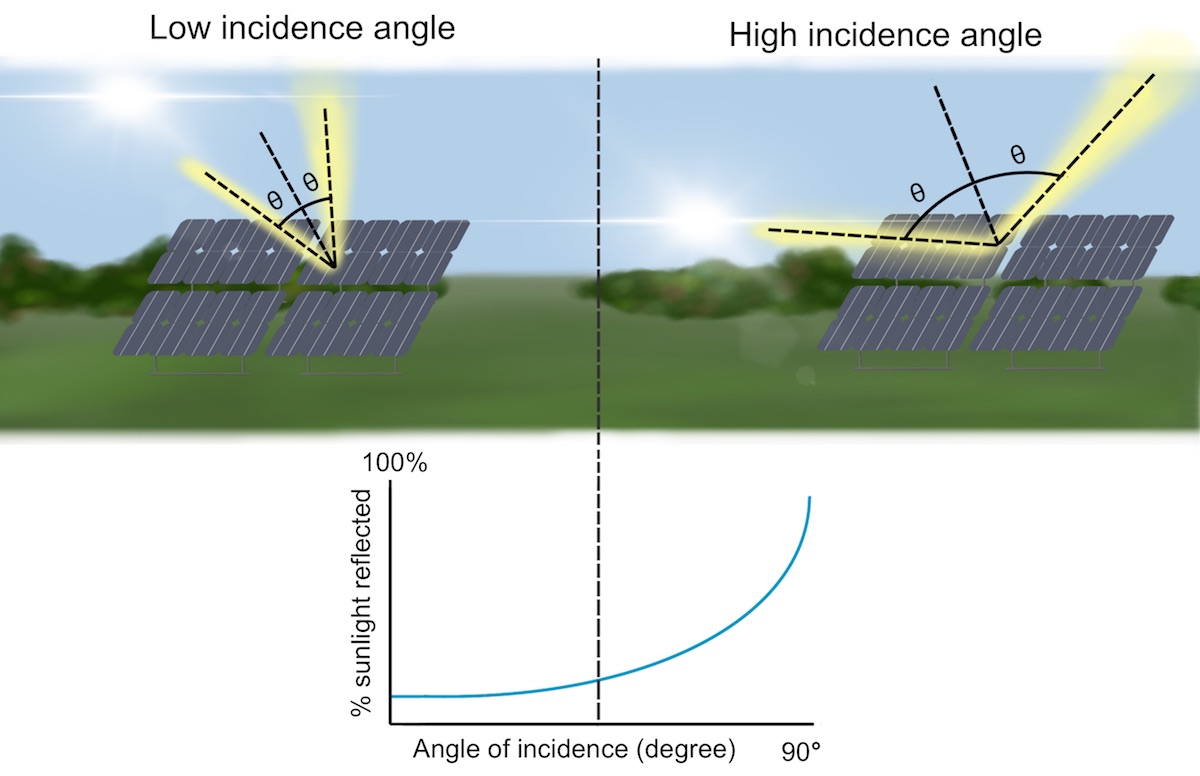
Module Reflectance Profiles
Sandia National Laboratories developed five generic PV module material reflectance profiles by analyzing over twenty PV module samples. These profiles are available in ForgeSolar and allow for customizing the material properties of the PV array during analysis.
The figure to the right illustrates the reflectance of each material profile as a function of incidence angle, where an angle of 0° implies the panels are directly facing the sun. For example, a high glancing angle near 90° for panels with 0° tilt (lying flat) occurs daily at sunrise and sunset.
Anti-reflective coatings (ARC) and surface texturing can reduce panel reflectivity, but this reduction is typically less than 8% (Yellowhair, 2015). In addition, greater surface texturing can increase the size of the subtended source angle (i.e. glare spot).
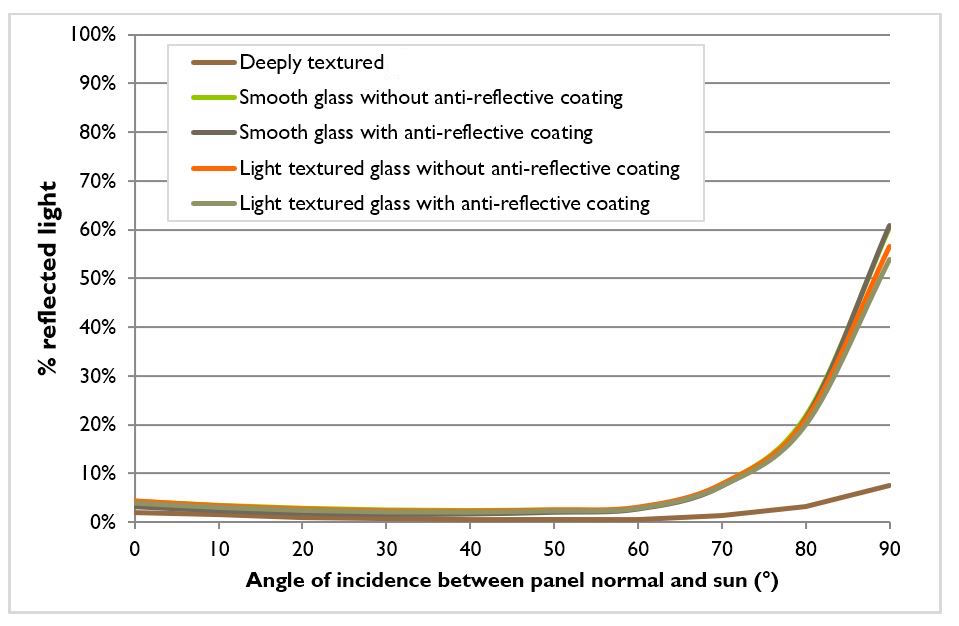
About Luminance
Various regulatory bodies require an assessment of the luminance of PV panels, rather than retinal irradiance or "green/yellow" ocular impact. ForgeSolar glare analyses can compute luminance characteristics for predicted glare via an optional setting in the editor Site Settings.
Typical luminance thresholds do not map directly to ocular impact categories. For example, the European Union Aviation Safety Agency (EASA) policy on solar panel glare requires a maximum acceptable luminance value of 20 000 cd/m2 (GM1 ADR-DSN.M.615 General (k)(2)). As illustrated in the chart below, a representative PV array reflecting this luminance yields a retinal irradiance several orders of magnitude lower than the after-image threshold of the ocular hazard chart.
Examples of typical luminance values are provided in the table below for reference when comparing glare outcomes. (Source: Wikipedia).
| Value (cd/m2) | Item |
|---|---|
| 1.6 * 109 | Solar disk at noon |
| 600 000 | Solar disk at horizon |
| 130 000 | Frosted incandescent light bulb |
| 20 000 | EASA threshold for PV glare |
| 12 000 | Fluorescent lamp |
| 8 000 | Average clear sky |
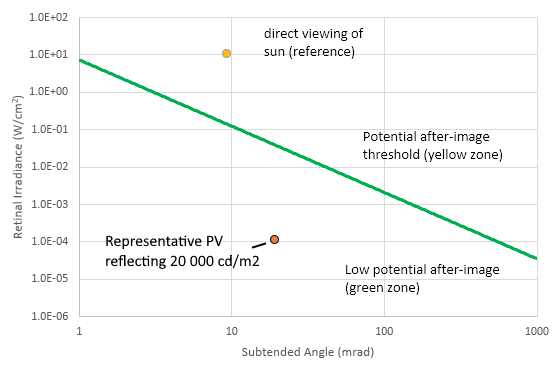
Workflow
Guidance on conducting glare analyses and optimizations
In ForgeSolar, sites and glare analyses are organized as follows:
Site Configuration - represents a group of one or more PV arrays (or Vertical Surfaces), each with a single module orientation and tilt, and relevant receptors. A comprehensive assessment may comprise more than one Site Config in order to evaluate various orientation and tilt options. A Site Config is the "atomic" unit of glare analyses, and is typically created in the Map Editor.
Glare Analysis - annual analysis of a Site Config to determine expected glare from PV arrays toward receptors.
Project - container which holds one or more related Site Configs in a specified timezone. A Project is akin to a folder containing all the Site Configs of a proposed PV installation.
Example: a proposed installation of PV arrays on two rooftops near San Francisco International Airport (SFO) could be organized as follows:
- One Project with timezone offset of -8
- One Site Config with both PV arrays and SFO receptors (flight paths, ATCT)
- More Site Configs, cloned from the original, to evaluate alternative PV module tilts and orientations
- Each Site Config would include glare analysis results after submission via the Editor
The ForgeSolar tools can also be used to conduct a module optimization analysis with the GlaReduce Optimization Tool. The Optimization analysis evaluates a single PV array over a range of tilts and orientations to aid in identifying the optimal module configuration. To conduct a PV array optimization, select GlaReduce Optimization from the Tools menu.
Projects
Projects are an organizational means of grouping together the related Site Configurations, analysis results, and Optimizations for a single real-world project. The quantity of glare analyses and optimizations available for a Project is determined by the Project Tier.
PV arrays within a project may be located up to 3 miles (5 km) from the first analyzed set of PV arrays. This project boundary is visualized in the editor as a blue circle encompassing the active project area.
Project Settings
- Project name
- Unique name to distinguish a particular project. For example, "LAX parking rooftop PV phase 1" or "Main street solar farm"
- Tier
- The project tier determines the PV system size, footprint area, and quantity of components that can be evaluated in a single glare analysis.
- Basic - PV systems up to 1 MW (8 acres), or projects containing Vertical Surfaces
- Advanced - PV systems of any size within project radius (5 km)
- V1 - projects created prior to the 2021A update
- Client
- Optional name of client which will be displayed with results
- Approximate system size
- PV system size range under analysis. Not applicable for Vertical Surface projects.
- Description
- Optional description for user convenience.
- Timezone offset
- Numerical +/- offset from UTC/GMT of the site location. For example, a site in New York, USA would utilize a timezone offset of -5. Options range from -12 to +14.
- Distance units
- Whether the distances, including heights and elevations, should be displayed in feet or meters.
| Project Tier | Basic | Advanced |
|---|---|---|
| System size (approx.) | < 1 MW | Any size |
| PV area | < 8 acres (32,370 m2) | Any size |
| Glare analyses | 20 | 30 |
| Optimizations | 5 | 5 |
| # PV footprints | 10 | 20 |
| # Vertical surfaces | 20 | 20 |
| # Flight paths | 20 | 20 |
| # Routes | 10 | 20 |
| # Observation points | 40 | 60 |
Site Configurations
A Site Configuration, or "site config", includes 1+ reflective surfaces and 1+ receptors. Use site configs to describe a particular configuration of PV array(s) and/or vertical surfaces. For example, a project may contain several site configs, each describing a different module tilt and orientation of the same set of PV array footprints.
Site configs can be cloned in the editor (Site Configuration -> Save As...) to quickly duplicate a set of components to, for example, evaluate an alternative module design without overwriting the original.
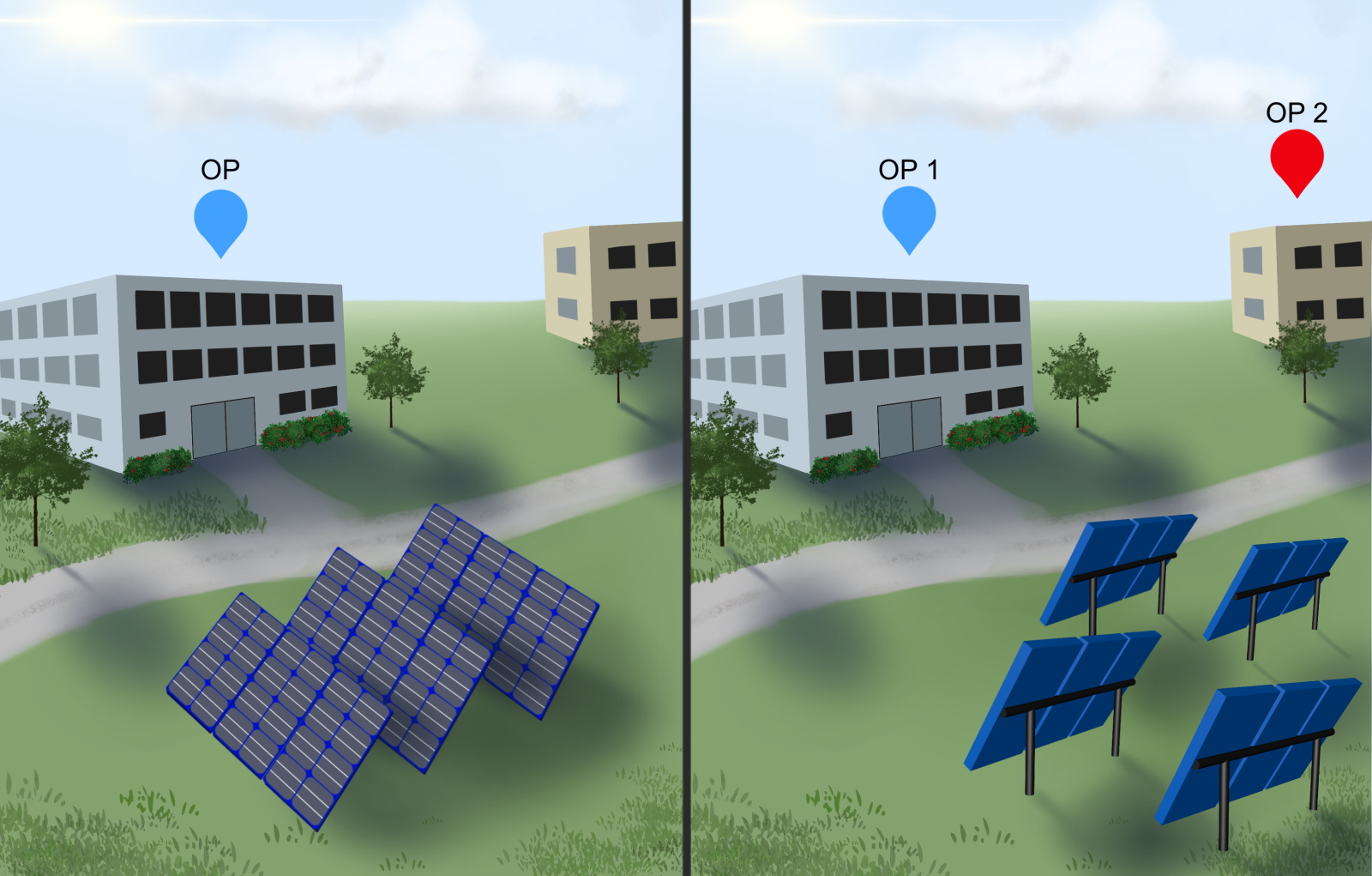
Site Settings
- Site name
- Alphanumeric name describing this site and configuration
- Configuration description
- Optional description of this particular site and configuration
- Time interval (min)
- The time step, or sampling interval, for the annual glare hazard analysis. The sun position will be determined at each time step throughout the year. Regulatory authorities typically require a time-step of 1 minute. Other values can be used to conduct faster analyses or "spot check" alternative configurations. The time interval must evenly divide 1440 (i.e. number of minutes in a day); suitable alternatives are 2, 4, 5, 10, 15, 20.
- Minimum sun altitude (deg) new
- Lower bound denoting the minimum altitude at which the sun is visible (year-round). Glare occurring when the sun is below this altitude will be ignored. For example, a PV location surrounded by large hills would have a higher Minimum sun altitude. Defaults to 0 °.
- Peak DNI (W/m2 or Wh/m2)
- The maximum Direct Normal Irradiance at the given location at solar noon. DNI is the amount of solar radiation received in a collimated beam on a surface normal to the sun during a 60-minute period. On a clear sunny day at solar noon, a typical peak DNI is ~1,000 W/m2. More accurate values for a specific site location may be available from other data sources. The data sets from the U.S. National Solar Radiation Database contain similar values for locations throughout the U.S.
- DNI varies?
- If checked, the peak DNI will be scaled at each time step according to the changing position of the sun and reduced DNI in the mornings and evenings. If unchecked, the DNI at every step will be set to the Peak DNI.
- Assess luminance new
- Instructs the analysis to compute glare luminance data (cd/m2) for the PV system(s) and receptors. The results will included luminance charts, peak luminance data, and per-step luminance data in the result data file.
- Create PV glare data file(s)?
- The glare analysis will also output an XLS file containing data on times of glare for each receptor
- Sun angle (mrad)
- The average subtended angle of the sun as viewed from earth is ~9.3 mrad or 0.5°.
- Use enhanced subtended source angle calculation?
- Whether the analysis utilizes improved computation of subtended source angle regarding glare-spot size (2022C Update).
- Ocular transmission coefficient
- Coefficient accounting for radiation that is absorbed in the eye before reaching the retina. A value of 0.5 is typical (Ho, 2011; Sliney, 1973).
- Pupil diameter (m)
- Defines the diameter of the pupil of the observer receiving predicted glare. The size impacts the amount of light entering the eye and reaching the retina. Typical values range from 0.002 m for daylight- adjusted eyes to 0.008 m for nighttime vision (Ho, 2011; Sliney, 1973).
- Eye focal length (m)
- Distance between the nodal point (where rays intersect in the eye) and the retina. This value is used to determine the projected image size on the retina for a given subtended angle of the glare source. A typical eye focal length is 0.017 m (Ho, 2011; Sliney, 1973).
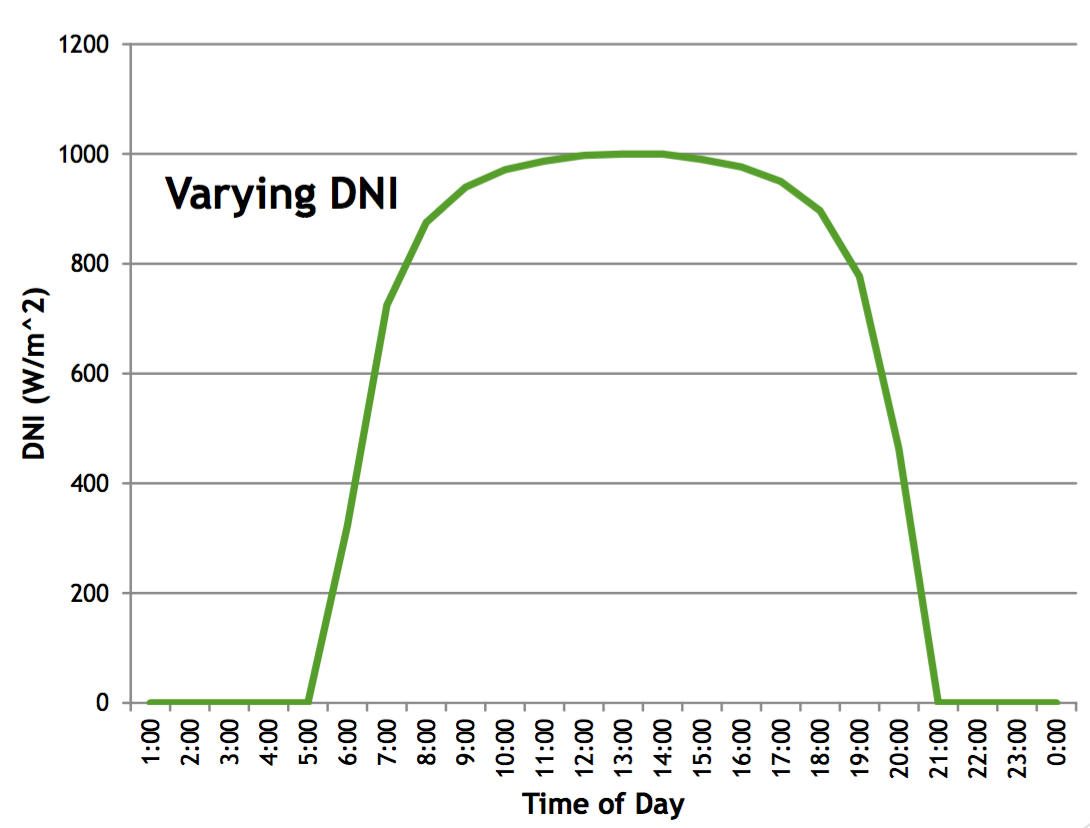
Site Component Data File
An XLSX data file containing site and component data can be exported from the Site Components & Results page after the site has been saved. This data file is distinct from the glare analysis data file, which contains analysis results. The Component data file can be used in the XLS Import feature to create a new copy of the site; for example, to quickly edit PV vertex coordinates and then import the modified version into the project.
For more information on the component parameters and descriptions, refer to the XLS Import Template.
The Site Component Data File also contains sample tracking data if PV systems utilizing single-axis tracking and newer backtracking strategies are modeled. This should be used to understand and verify the tracking behavior. Tracking data is provided for each SAT system in separate worksheets and includes data and plots for Jan. 1, Jun. 21, and Dec. 21. Tracking data includes:
Time: the time-step of sampled data, in 10-minute increments
Sun altitude (°): elevation of sun above horizon.
Sun azimuth (°): orientation of sun, measured clockwise, with true north at 0°.
PV normal vector (i,j,k): vector components of normal vector describing PV module configuration. Components are (east, north, up). e.g. flat panels lying on flat ground have a normal vector of (0, 0, 1).
PV rotation angle (°): panel rotation angle, including backtracking, measured +west with flat at 0°. (Note that the vector component is +east.)
PV true tracking angle(°): "ideal" panel rotation angle, ignoring backtracking.
1. Navigate to the Site Component & Results page
2. Click the More... button on the top right
3. Select Export component data from the dropdown menu.
Analysis Results
Glare analysis results are displayed on the Site Configuration Components & Results page after an analysis is submitted in the Editor. Results are displayed in the following sections:
- Analysis results header
- Glare Analysis Summary tab
- PV Array Results tab
- Vertical Surface Results tab
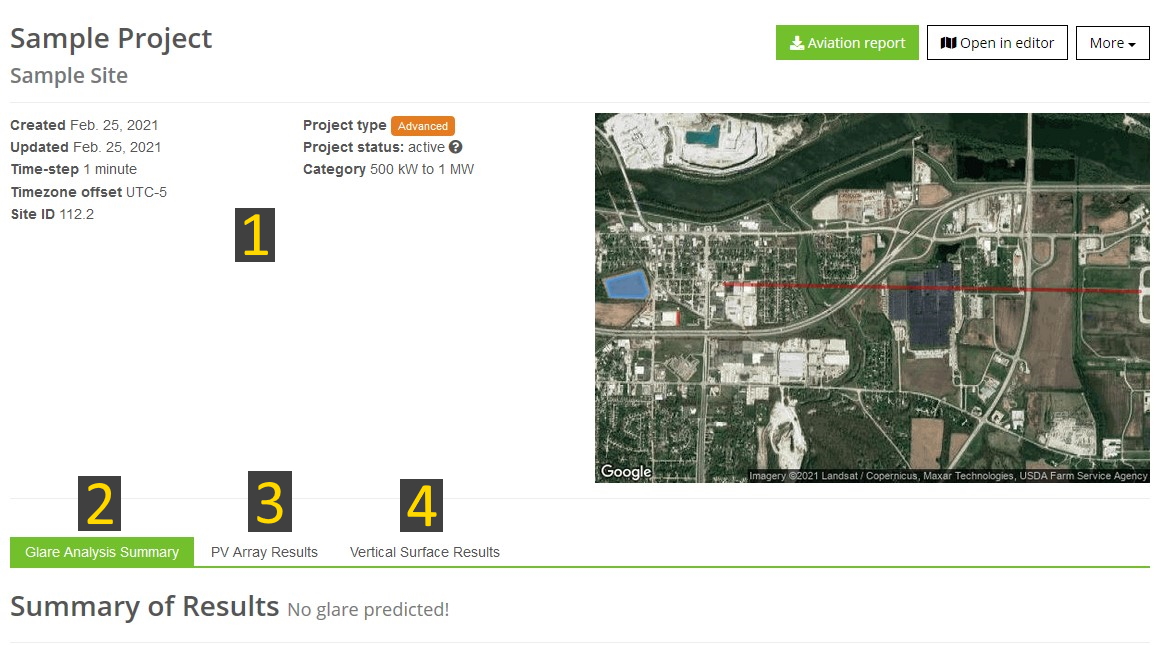
The various properties and component parameters should be verified before utilizing glare analysis results, to ensure their accuracy.
Result Header Section
The Result page header displays various properties of the project and site configuration, and includes additional buttons to generate an aviation report, open the Editor, and export a component data file.
A non-interactive Google map displaying the components will also appear in the header section. (Note that this map may not be displayed for complex sites, due to map generation limitations.)
Glare Analysis Summary Tab
The Glare Analysis Summary tab, which is displayed when first loading the site config page, includes a table summarizing expected glare, as well as compact tabulations of components and their parameters. Use this tab to quickly review components and analysis results.
PV Array Results Tab
The PV Array Results tab contains detailed data and visualizations of expected glare. The results are organized by PV array and then by component. A summary of glare expectations is provided first, and includes clickable PV names for convenient navigation.
A table of distinct glare, tabulated by month, is displayed below the analysis summary table. It describes total non-overlapping glare expected from each PV array for all receptors (see figure).

PV array analysis results for which glare is predicted will include various plots describing the expected times, duration, and location of glare for each receptor, on an annual basis. These plots are described below.
Note that plots will not be displayed when no glare is predicted for a particular receptor of PV array. Furthermore, some plots are excluded from the aviation report.
Annual Glare Occurrence Plot
The annual glare occurrence plot displays the approximate times of year and times of day for which glare is expected for the specified receptor. The x-axis denotes the times of year, while the y-axis indicates times of day. Occurrences are color-coded by predicted ocular impact.
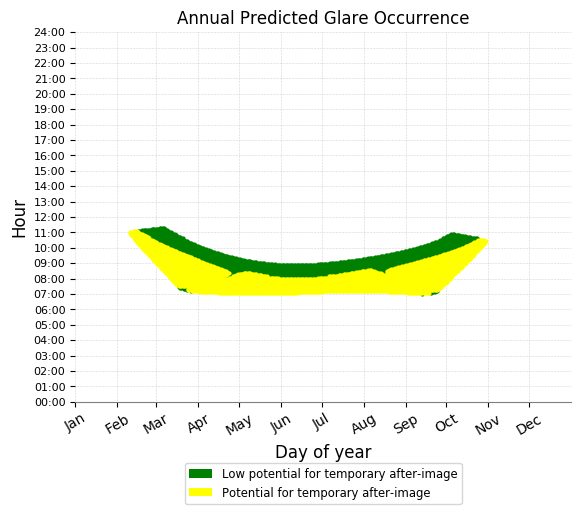
Daily Glare Duration Plot
The daily glare duration plot sums expected minutes of glare on a daily basis to provide an approximation of the total number of minutes glare will be evident each day, on an annual basis.
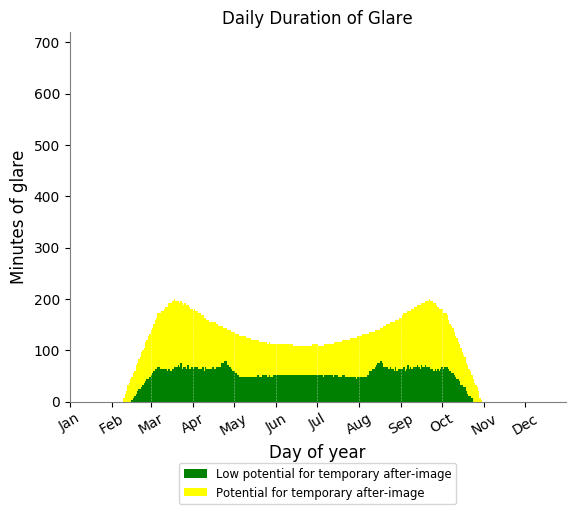
Glare Hazard Plot
The glare hazard plot presents the expected ocular impact of each minute of predicted glare. The x-axis represents the subtended source angle, i.e. the angle subtended by the visible glare spot. The y-axis represents the retinal irradiance impacting the observer.
The three hazard zones, described by the colors green, yellow, and red, are derived from literature and indicate the expected impact (see About Glint & Glare section.
The reference point (yellow with blue outline) indicates the hazard due to viewing the unfiltered sun.
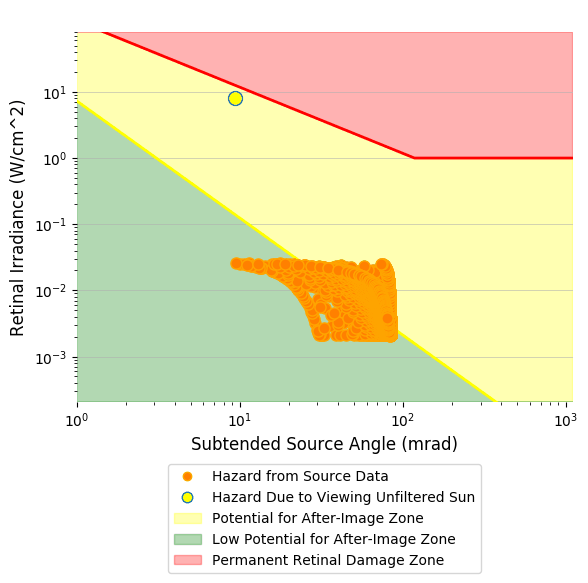
Plot of Path location and Time of Glare
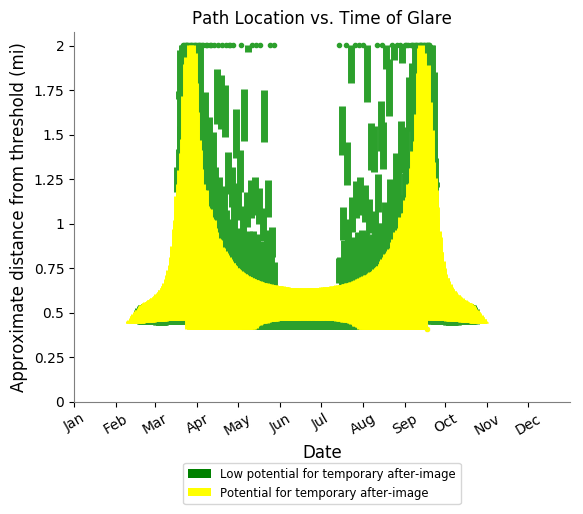
PV Footprint Glare-Spot Heatmap Plot
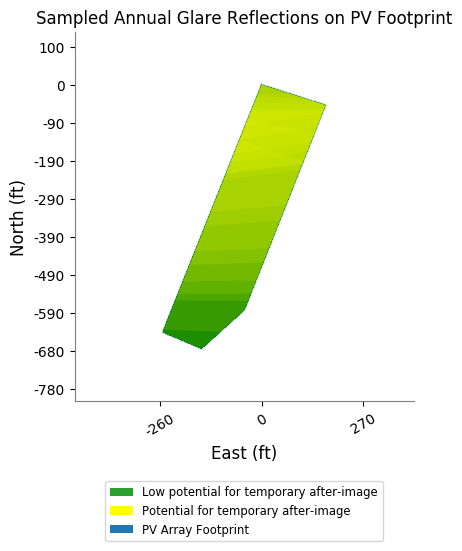
Plot of Path Positions Receiving Glare
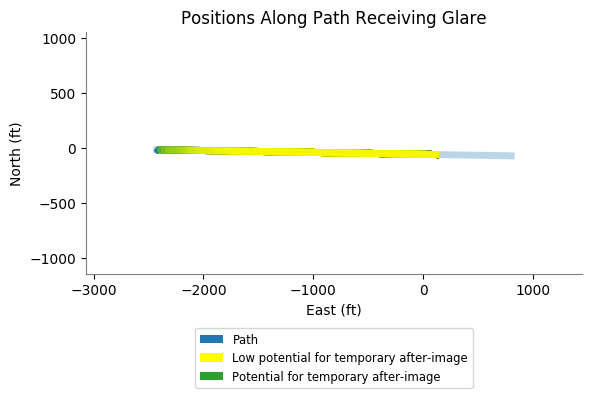
Peak Luminance Charts
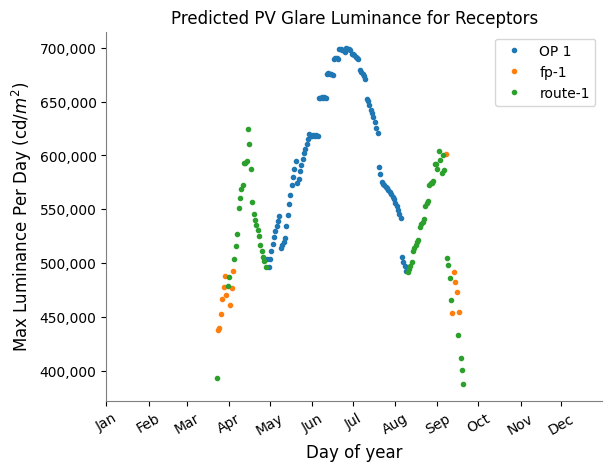
Result Data Files
An XLS data file describing the times and characteristics of glare can be generated for each PV array and Vertical Surface. To enable data file creation, check the Create glare data file? option under the Site Config settings in the Editor.
The data file includes a worksheet for each receptor expecting glare. Glare characteristics for each time-step are tabulated in each sheet. Included data is described below. Note that some times of glare included in the data file may be excluded from the analysis results due to filtering.
- Corneal Irradiance (W/cm2)
- Irradiance (flux per unit area) at plane in front of cornea, from glare emanation
- DNI (W/m2)
- Direct Normal Irradiance from sun at location. Derived from scaling Peak DNI according to time and sun position.
- Ocular Hazard #
- Numeric representation of predicted glare hazard: 0 (no glare), 1 (green glare), 2 (yellow glare)
- Reflectivity
- Fraction of light reflecting toward receptor. Reflectivity depends on material, module configuration, and sun position.
- Retinal Irradiance (W/cm2)
- Irradiance (flux per unit area) impacting retina, at back of eye. Defines y-axis of hazard plot. Note that retinal irradiance does not depend on distance to source.
- Subtended Glare Angle (rad)
- Angle subtended by glare spot on PV array from point-of-view of receptor (i.e. effective glare spot size when viewed by observer). Defines x-axis of log-log hazard plot.
- Sun Azimuth (°)
- East/north component of angular position of sun. Measured clockwise from true north at 0°. Azimuth of 180° indicates sun is due south.
- Sun Altitude (°)
- Vertical (elevation) component of angular position of sun at given time. 0° implies sun is at horizon (i.e. sunrise/sunset). 90° indicates sun is directly overhead.
- Sun Position Vector (i, j, k)
- Cartesian unit vector describing position of sun, extending from PV array. (i, j, k) components represent (east, north, up).
- Reflected Sun Vector (i, j, k)
- Cartesian unit vector describing reflected sunlight emanating outward from PV array. i.e. path of glare. Note that methodology simulates glare as polyhedral or conical emanation to account for beam spread; this vector defines the conical/polyhedral axis.
- Sun/module incidence angle (°)
- Angle between panel normal vector and sun position vector. Angle of 0° indicates panel is directly facing sun. Angle of 90° indicates sun and panel vectors are orthogonal to each other (e.g. panel on flat ground and sunrise/sunset).
- Luminance (cd/m2)
- Solar glare luminance for human viewer observing glare source. This value utilizes the subtended glare angle of the reflected beam, the reflectance as a function of angle of incidence of the sun, and a direct solar luminance of 1.57E+9 cd/m2.
Printable Analysis Reports
Printable PDF documents can be downloaded to preserve glare analysis results. Several report variations are available and are described below. These reports can be obtained from the Site Configuration Results page, via the "Reports" button.
Generic Analysis Report
new
The generic analysis report includes all analysis results except the "distinct glare per month" data table.
It includes data and plots for each reflective surface and receptor component.
This report duplicates the contents of the glare analysis results page for local storage and can act
as documentation of the site evaluation.
FAA 2021 Aviation Report
new
The 2021 FAA report document is themed for the U.S. Federal Aviation Administration
Final Policy
regarding PV projects on federally-obligated airports, released in May 2021.
This report includes an executive summary page which estimates the adherence of the site results
according to this policy, which requires no glare for Air Traffic Control Towers.
FAA 2013 Aviation Report
The 2013 FAA document is themed for the U.S. Federal Aviation Administration
Interim Policy
regarding PV projects on federally-obligated airports, released in 2013.
This report includes an executive summary page which estimates the adherence of the site results
according to this policy, which requires no glare for Air Traffic Control Towers and no yellow glare
for aircraft on a 2-mile straight approach path.
If these reports do not satisfy your documentation needs, contact us to submit feedback.
Reflective Surface Components
PV arrays and Vertical Surfaces represent reflective surfaces which can contribute to glare.
PV Array Component
Photovoltaic systems are represented by a contiguous planar polygon footprint and a set of customizable parameters. Each distinct PV installation must be modeled with it's own PV array footprint in the editor. PV footprints comprise 3 to 80 vertices which are described by a latitude, longitude, elevation and height.
During analysis, sunlight is reflected over each PV array on a minute-by-minute basis according to the user-specified module tilt and orientation or axis tracking parameters if the system is not fixed-mount. The system then checks whether the resulting solar reflections intersect (impact) the receptors.
PV Array Footprint
PV arrays are simulated spatially with a contiguous planar convex polygon. This polygonal footprint comprises three or more vertices which are defined by a latitude, longitude, elevation and height. The footprint should encompass all planned PV modules in a given area. Non-contiguous PV systems, or those with substantial concavities, should be modeled with multiple PV array footprints.
Note that rows of adjacent PV modules should typically be modeled with a single PV footprint. It is not necessary to create a new footprint for each row of similarly-configured modules. This can artificially constrain the potential glare-spot size and reduce analysis accuracy.
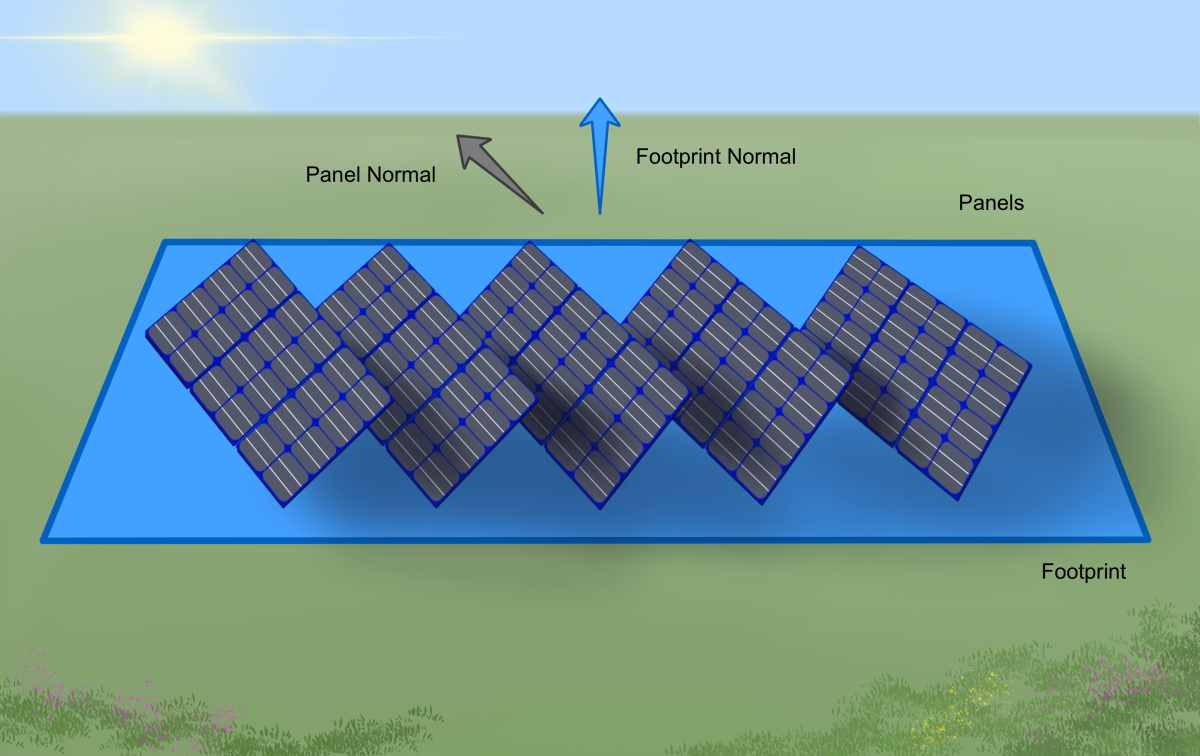
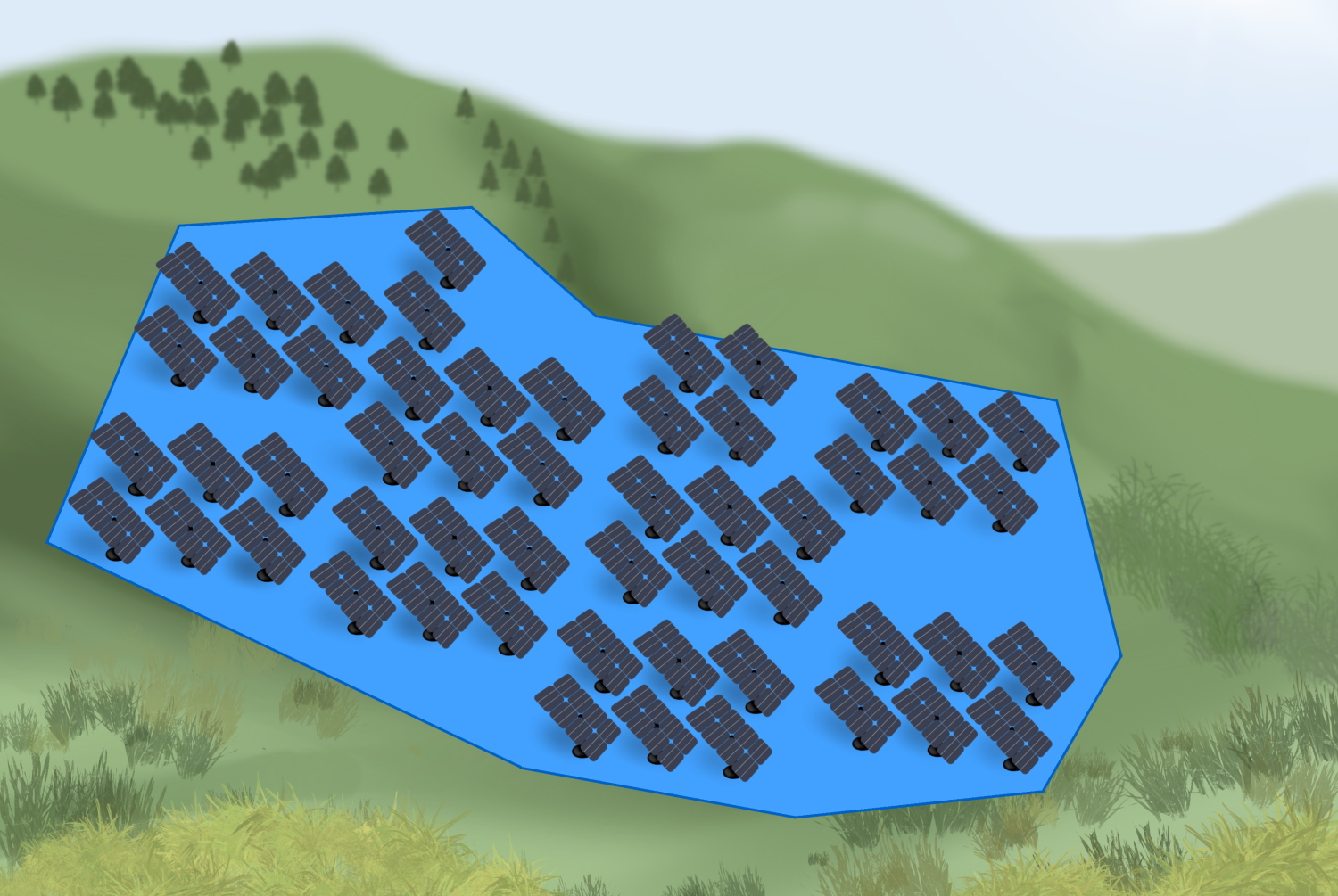
ForgeSolar will modify the vertex elevations if they do not initially reside on a single planar surface. For example, if a user attempts to model a non-planar footprint, such as multiple sides of a hill, the system would smooth the footprint and effectively flatten the hill. (In this example, a more accurate approach would be to model each hillside as a separate PV array.)
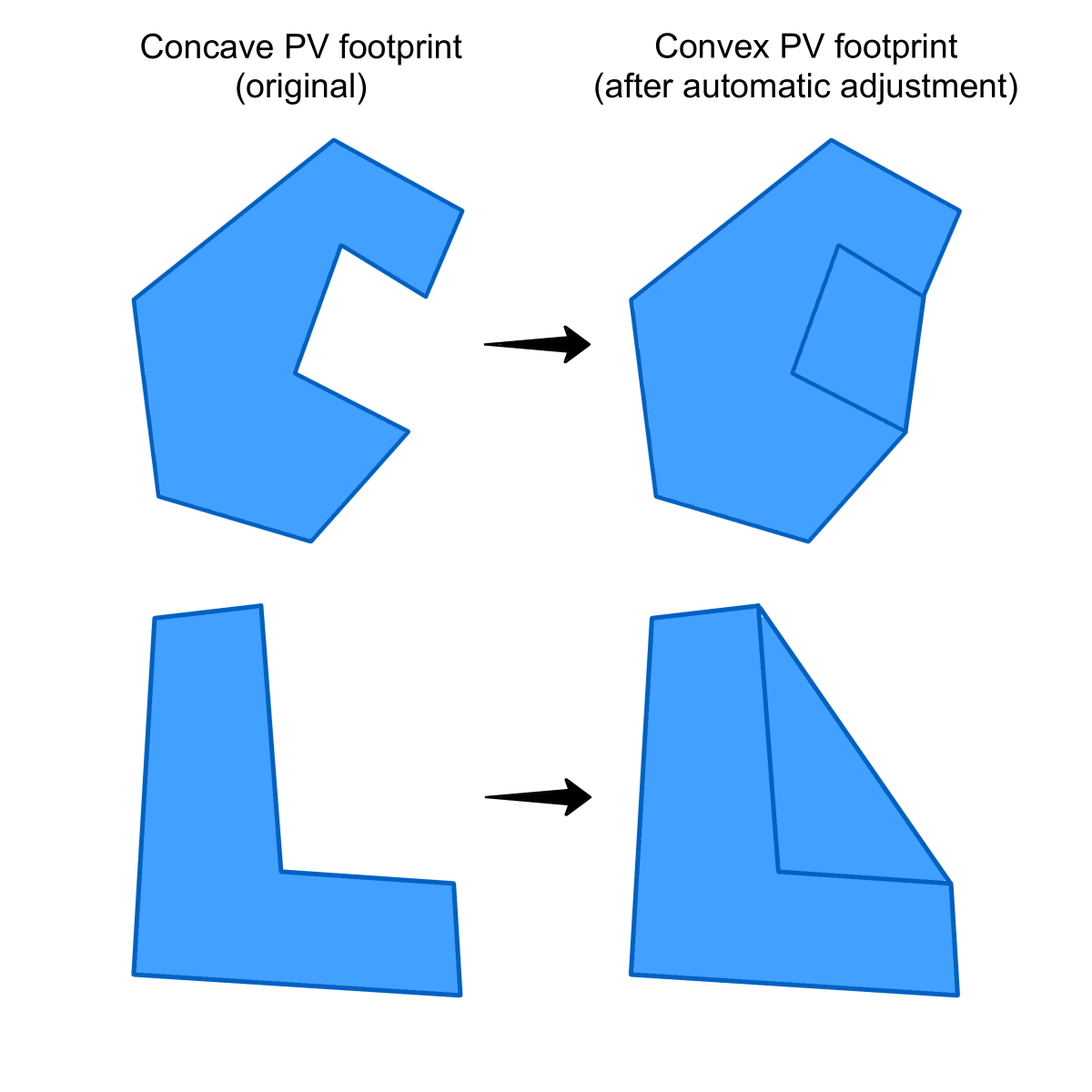
Note that ForgeSolar may convert the footprint polygon into a convex polygon during analysis by filling in any concavities. For example, a 'C'-shaped footprint would be modified into a half-circle. Large PV array sites with many concavities may be assessed more accurately by partitioning the footprint into multiple footprints.
Similarly, PV footprints should not include extraneous "bridges" or artificial connections that yield substantial concavities, in order to link together footprints that are not adjacent.
PV footprint vertex coordinates, including elevation, are independent of the orientation and tilt. The vertices establish the tilt of the PV-array plane and do not influence the tilt or orientation of the individual panels themselves. For example, panels mounted flush on a 30° pitched roof will have PV-array vertices with different elevations to accommodate the pitched roof and resulting tilted PV-array plane (e.g., two vertices at 15 feet and two vertices at 10 feet). However, the panels should still be prescribed with a tilt of 30° (if they are flush mounted against the 30° pitched roof) and the appropriate orientation. A tilt of 0° indicates that the panels are parallel with the earth’s surface and facing upward, regardless of the prescribed vertex elevations.
ForgeSolar does not rigorously represent the detailed geometry of a system; detailed features such as gaps between modules, variable height of the PV array, and support structures may impact actual glare results. The PV array is simulated as a footprint filled with infinitesimally small panels reflecting sunlight in the trajectory of the tilt and orientation.
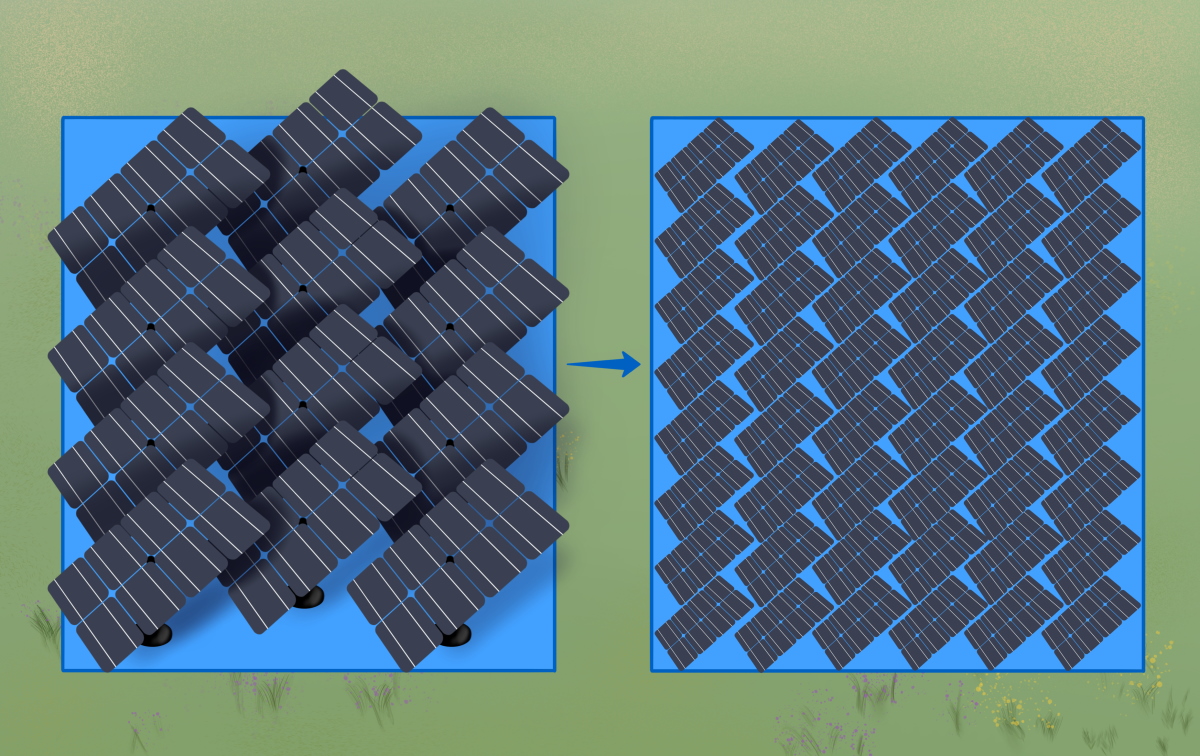
PV Array Parameters
General PV array parameters are described below. Module configuration, tracking and vertex parameters are described in subsequent sections.
- Name
- Descriptive alphanumeric name of this PV array
- Description
- Optional textual description of array
- Axis tracking
- Whether PV array modules are fixed-mount or utilize single- or dual-axis tracking. Tracking parameters are described in later sections.
- Rated power (kW)
- Used to calculate the approximate maximum annual energy produced (kWh) from the system in the prescribed configuration (assuming clear sunny days). This is useful for comparing alternative configurations to determine which one has the maximum energy production. ForgeSolar system output calculations are approximate and should not supercede more accurate calculations conducted elsewhere.
- Module surface material
- The type of material comprising the PV modules. The reflectivities of the material choices have been characterized to generate scaled values for each time step. Refer to the Module Reflectance Profiles section for additional information.
- Reflectivity varies with incidence angle
- If checked, the reflectivity of the modules at each time step will be calculated as a function of module surface material and incidence angle between the panel normal and sun position.
- Reflectivity
- Specify the solar reflectance of the PV module. Although near-normal specular reflectance of PV glass (e.g., with antireflective coating) can be as low as ~1-2%, the reflectance can increase as the incidence angle of the sunlight increases (glancing angles); for example, at sunrise and sunset for low-tilt panels. Based on evaluation of several different PV modules, an average reflectance of 10% is provided as a default value. Only used if reflectivity does not vary with incidence angle.
- Slope error (mrad)
- Specifies the amount of scatter that occurs from the PV module. Mirror-like surfaces that produce specular reflections will have a slope error closer to zero, while rough surfaces that produce more scattered (diffuse) reflections have higher slope errors. Based on observed glare from different PV modules, an RMS slope error of ~10 mrad (which produces a total reflected beam spread of 0.13 rad or 7°) appears to be a reasonable value. Not used if correlate slope error to module surface type is checked.
- Correlate slope error with surface type
- If checked, the slope error value will be set per the table below, based on the selected material.
| PV Cover Type | Average RMS Slope Error (mrad) | Average Beam Spread (mrad) | Standard deviation of slope error | Standard deviation of beam error |
|---|---|---|---|---|
| Smooth glass without anti-reflection coating | 6.55 | 87.9 | 4.43 | 53.3 |
| Smooth glass with anti-reflection coating | 8.43 | 110 | 2.58 | 30.9 |
| Light textured glass without anti-reflection coating | 9.70 | 126 | 2.78 | 33.3 |
| Light textured glass with anti-reflection coating | 9.16 | 119 | 3.17 | 38.0 |
| Deeply textured | 82.6 | 1000 | N/A | N/A |
Fixed-Mount Parameters
Fixed-mount PV panels are described by a tilt and orientation. These parameters are referred to as the module configuration of the PV array.
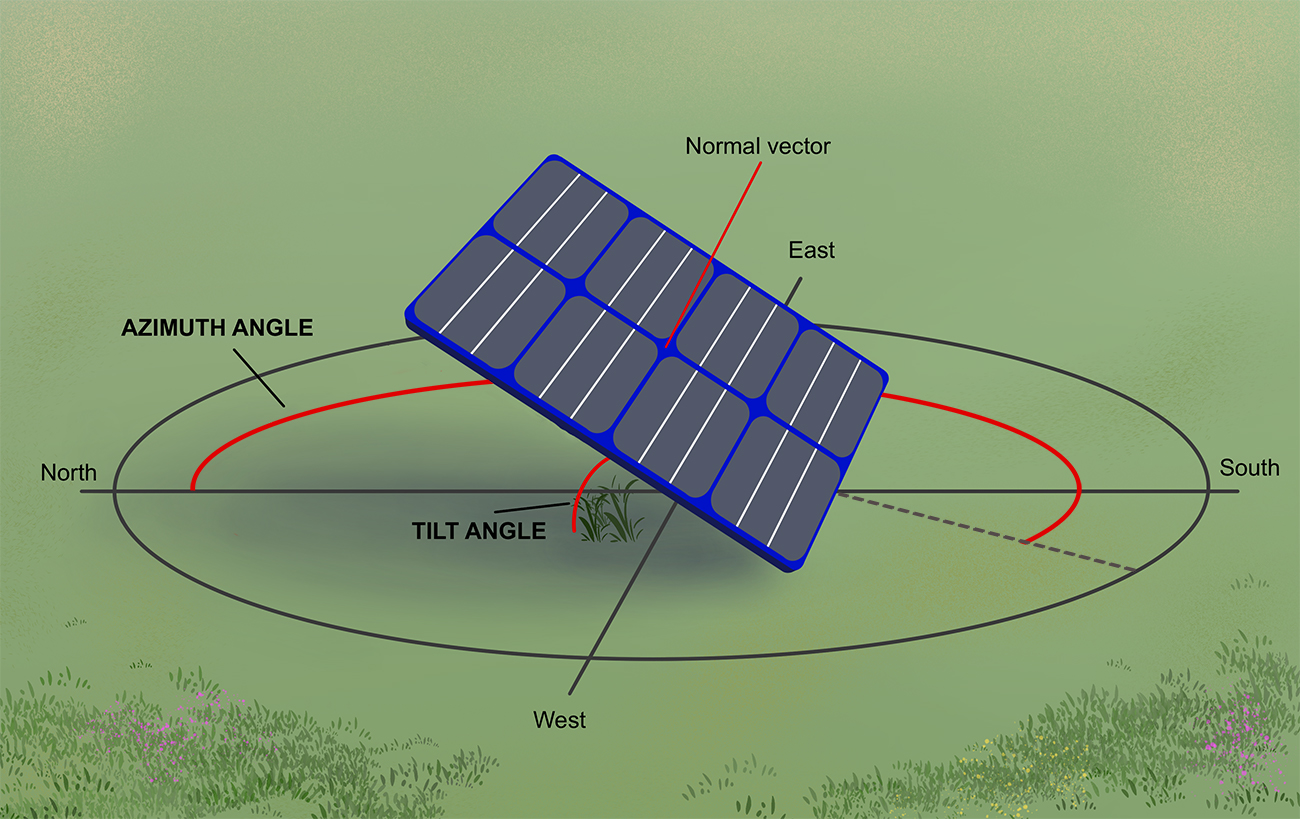
- Module orientation/azimuth (°)
- The azimuthal facing or direction toward which the PV panels are positioned. Orientation is measured clockwise from true north. Panels which face north, which is typical in the southern hemisphere, have an orientation of 0°. Panels which face south, which is typical in the northern hemisphere, have an orientation of 180°. If a known orientation is based on magnetic north, the location-specific declination must be used to determine the orientation from true north.
- Module tilt (°)
- The elevation angle of the panels, measured up from flat ground. Panels lying flat on the ground (facing up) have a tilt of 0°. Tilt values between 0° and 40° are typical.
Vertex Parameters
PV Arrays can comprise up to 80 vertices. Each vertex is described by the following parameters.
- Latitude (°)
- North-south measurement of location relative to the equator, with range of [-90° to 90°]. Latitude is measured in decimal degrees and assumes the WGS84 datum.
- Longitude (°)
- Measurement of east-west position relative to Prime Meridian, with range of [-180°, 180°]. Longitude is measured in decimal degrees and assumes the WGS84 datum.
- Elevation/altitude (ft or m)
- Elevation above mean sea level at specified location. ForgeSolar automatically queries the Google Elevation services for an approximate value.
- Height above ground (ft or m)
- User-specified height above ground of point. The height of a rooftop PV system should measure from the ground to the PV panel centroid above the roof. A ground-mount system would have a height measured to the PV panel centroid.
- Total elevation (ft or m)
- Sum of the elevation and height above ground. The system will automatically calculate the height or total elevation when the other is provided. During analysis, the total elevation determines the Cartesian Z value of the point. For more accuracy, the user should perform analyses using minimum and maximum values for the vertex heights, based on the PV panel dimensions, to bound the height of the plane containing the solar array. Doing so will expand the range of observed solar glare when compared to results using a single height value.
- Vertex Overrides
- Use these optional convenience inputs to quickly set a matching column value across all vertices in a component. For example, if the vertices share a known height above ground (such as a building rooftop height), you can use the input below the height above ground column to set the height values for all vertices.
PV Module Tracking
ForgeSolar can simulate single- and dual-axis tracking PV systems. Single-axis trackers follow the sun in one dimension (east-west), whereas dual-axis trackers track the sun in both dimensions.
- To model single-axis tracking, set the tracking parameter to single.
- To model dual-axis tracking, set the tracking parameter to dual.
Corresponding inputs for PV tracking will appear in the editor after the tracking parameter is adjusted.
Single-Axis Tracking
Single-axis trackers, or SAT systems, follow the rotation of the sun along the east-west axis throughout the day. SAT arrays are typically oriented with their axis of rotation aligned north-south. SAT systems may reduce glare for nearby receptors because they typically reduce the incidence angle between the modules and the sun, yielding smaller glancing angles and a higher vertical trajectory for glare reflections.
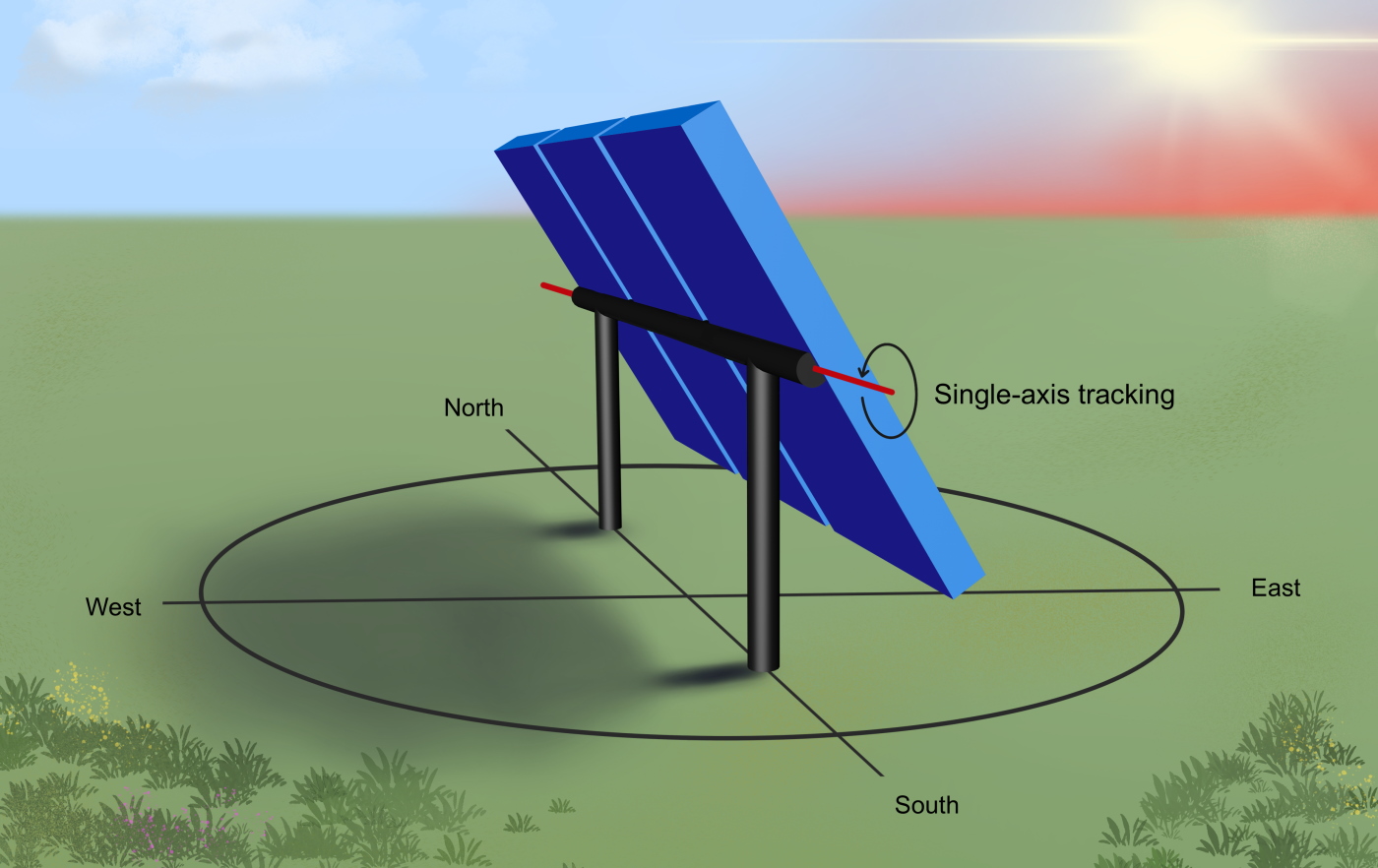
The rotation angles over which the modules track the sun daily is referred to as the range of rotation or window of rotation. The limits of this range are set by the maximum tracking angle, which is applied in both positive and negative directions. In other words, the SAT range of rotation equals twice the maximum tracking angle. For example, a PV system with a maximum tracking angle of 60° will track the sun daily through a full range of rotation of 120° (+/- 60° east to west) and will backtrack (if enabled) when the sun is outside this range or when too much shading occurs, depending on the backtracking strategy selected.
On the Details page, click the More... button at the top right, then select Export component data.
Backtracking
The backtracking PV parameter can be used to simulate various strategies that rotate the modules away from the sun to reduce shading. These strategies typically take effect when the sun's position lies outside the range of rotation defined by the maximum tracking angle of the PV panels, or when substantial shading occurs, depending on the strategy selected. The backtracking strategies simulated in ForgeSolar may deviate from real-world backtracking behavior due to system design, environmental conditions, and other factors. Tracking data and plots should always be reviewed to verify the expected panel tracking behavior (see note above).
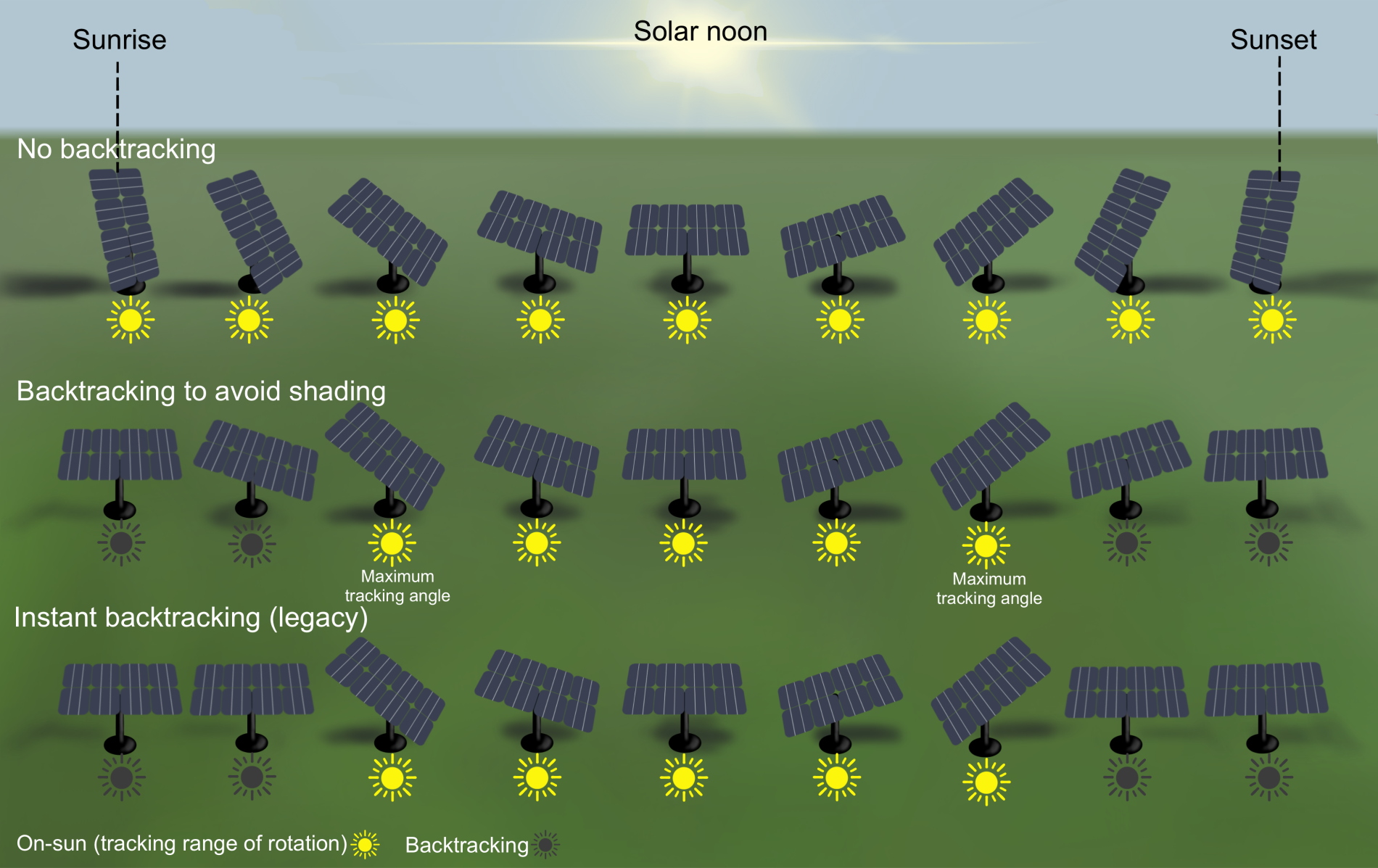
The following backtracking strategies are available in ForgeSolar:
shade: non-slope-aware temporal strategy that assumes panels are on flat ground. This option is selected by default for newly-created PV arrays. This option may lose accuracy for systems built on a substantial slope (i.e. with vertical offsets between rows.) This strategy is derived from (Lorenzo, 2011).
shade-slope: slope-aware method designed to accommodate PV modules placed on arbitrarily-oriented slopes and reduce shading. This option is selected by default for newly-created PV arrays. This strategy is derived from (Anderson, 2020).
interval: step-based method that discretely backtracks the PV modules over time.
instant: "legacy" implementation wherein PV modules immediately revert to the rest position, defined by the rest angle input, whenever the sun is outside the range of rotation. Note: this simplified strategy is available "as-is" as a legacy option to preserve the previous backtracking approach of SGHAT/ForgeSolar prior to the 2022A Update. Newer implementations of backtracking, such as shade-slope or shade, are recommended.
none: PV modules rotate to track the sun through the range of rotation determined by the (+/-) maximum tracking angle. The modules will not rotate beyond this limit and will not backtrack. This option effectively disables backtracking for single-axis tracking systems.
--
The following graphics illustrate the difference in rotation angle when backtracking is used. The PV system in the first graphic uses single-axis tracking without backtracking. The panel rotation angle matches the true tracking angle throughout the day.
The second graphic includes backtracking, whereby the panel rotation angle deviates from the true tracking angle when the sun position causes substantial shading between panels. Similar plots can be generated for a modeled SAT PV system from the Site Configuration page. For instructions on obtaining these plots, refer to the Component Data File section.
SAT PV Without Backtracking:
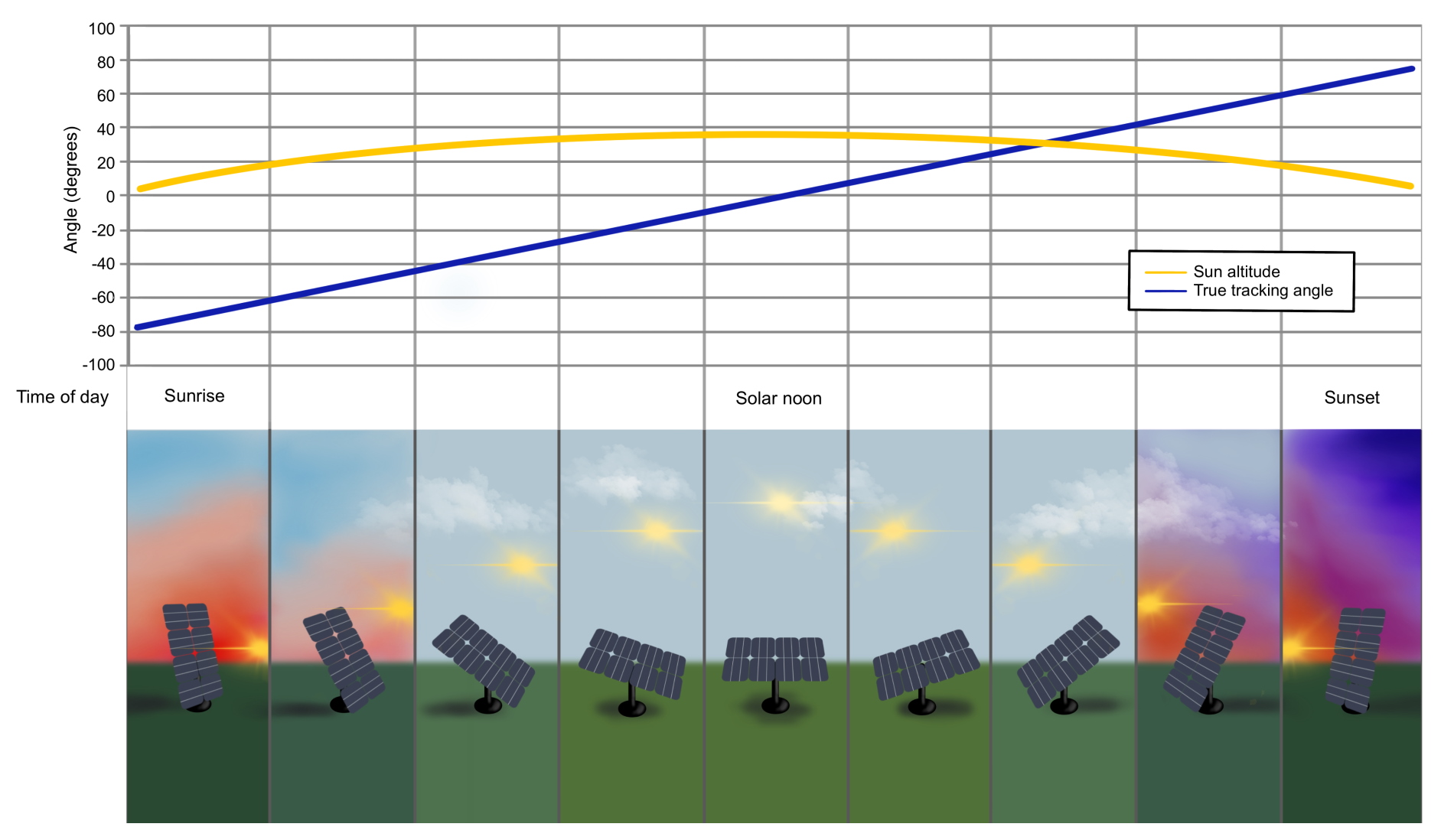
SAT PV With Backtracking:
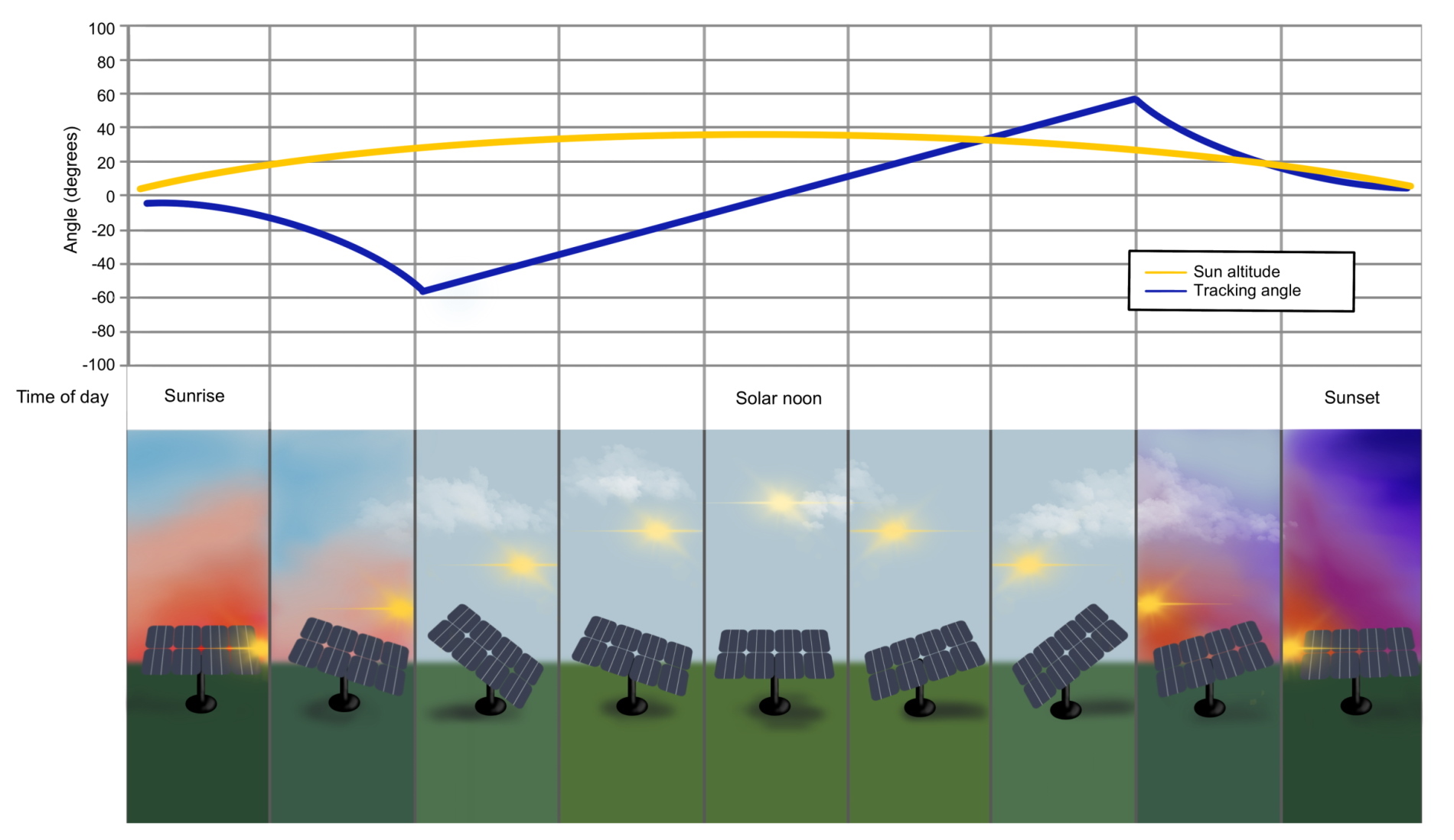
Tracking System Parameters
SAT systems utilize one or more of the following PV parameters. The selected backtracking strategy determines which parameters are available.
- Backtracking
- Backtracking strategy to simulate. See above for descriptions of available options.
- Orientation of tracking axis (°)
- Azimuthal angle of axis over which panels rotate. Angle represents the facing of the axis and system. Measured clockwise from true north at 0°. For example, tracking systems in northern hemisphere typically utilize a "south azimuth" tracking axis with an orientation of 180°, allowing panels to rotate east-west with south-facing tilt (if any). SAT systems in the southern hemisphere are typically oriented at or near 0°, yielding east-west rotation with north-facing tilt.
- Note that SAT analysis methods are designed for axis orientations near 0° and 180°. Accuracy may be reduced if the rotation axis significantly deviates from north-south. For example, an axis orientation of 90° or 270° will yield low-quality results.
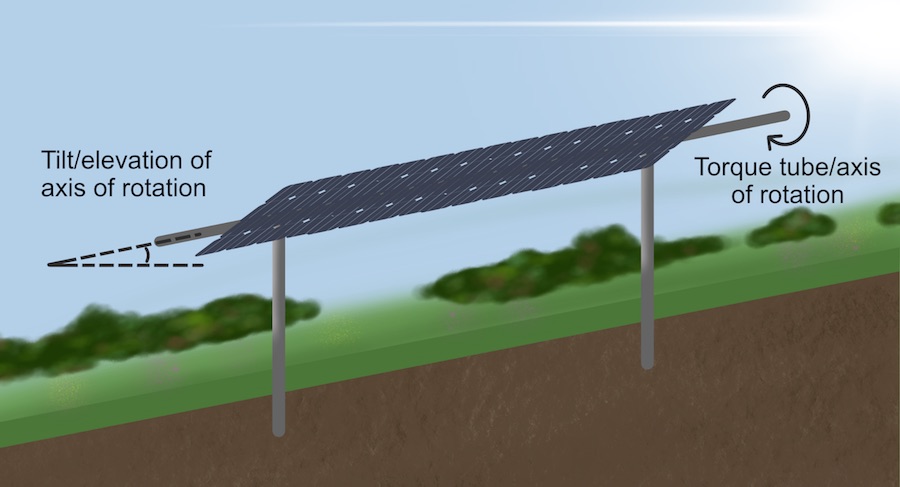
- Tilt of tracking axis (°)
- Tilt above flat ground of axis over which panels rotate (e.g. torque tube). System on flat, level ground would have axis tilt of 0°. Tracking axis tilt is only used by instant and none backtracking strategies. Other backtracking strategies either compute the tilt from the slope (shade-slope) or assume the modules are on flat ground with no axis tilt.
- Maximum tracking angle (°)
- Maximum angle of rotation of tracking system in both east and west directions. For example, a typical system with a 120° range of rotation has a max tracking angle of 60° (east/west).
- Resting angle (°)
- Angle of rotation of panels when sun is outside tracking range and backtracking rotation has settled. In legacy "instant" backtracking, panels revert to the position described by this rotation angle at all times when the sun is outside the rotation range. In backtracking modes shade, shade-slope, and interval, the rest angle describes the most shallow possible angle of east/west rotation of panels during times of possible backtracking (i.e. early morning and late evening). For example, a system with backtracking strategy "shade" and rest angle of 5° will begin the day at 5° east, rotate toward the sun, then follow it's path until backtracking again activates in the evening. The panels will then backtrack toward a final rest position of 5° west. Depending on the backtracking and location, the panels may not always reach the rest angle position while the sun is up.
- GCR
- Ground-coverage ratio of PV system, defined as ratio between the PV module area and total ground area. Used by shade-slope and shade Backtracking strategies.
- Offset angle of module (°)
- Additional tilt angle of PV module elevated above tracking axis/torque tube. Offset angle is measured from the torque tube and is only applicable to instant and none backtracking strategies.
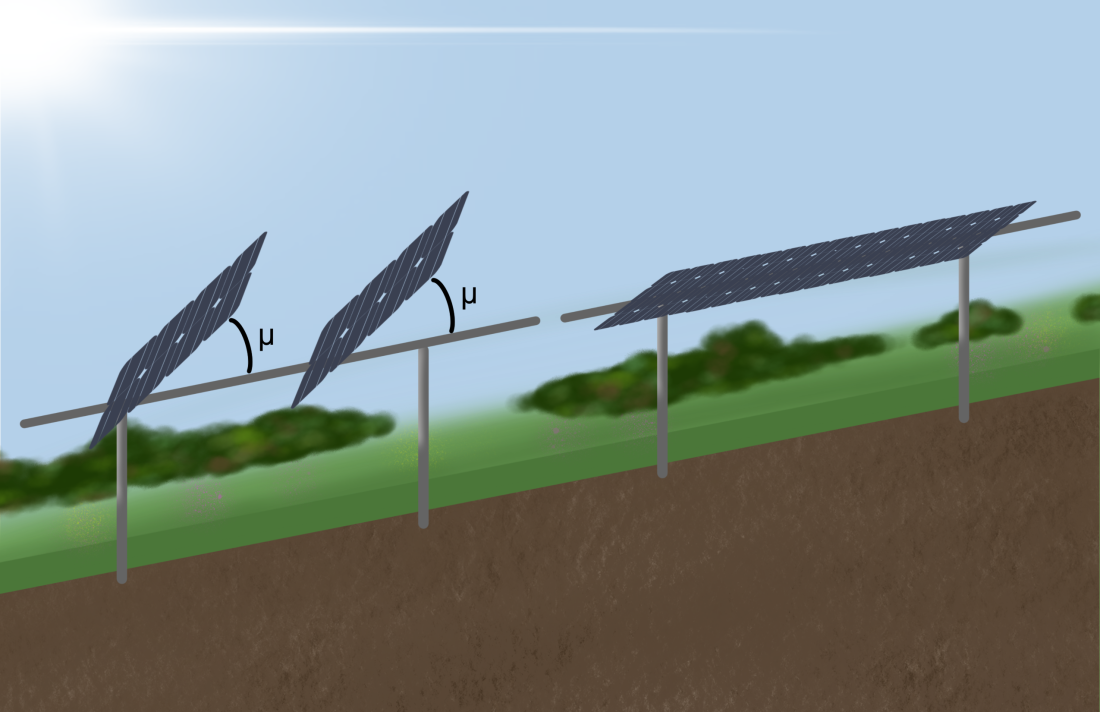
Dual-Axis Tracking
ForgeSolar simulates dual-axis tracking systems by setting the module normal vector according to the position of the sun at each daytime time-step. The trackers will follow the sun in both dimensions, from sunrise until sunset. ForgeSolar does not currently model backtracking with dual-axis tracking systems.
Vertical Surface Component
Non-PV vertical reflective surfaces, such as glass buildings and reflective billboards, can be modeled with the Vertical Surface ("VS") component. Each Vertical Surface is described by a path of two or more vertices and lower and upper edge heights which bound the portion of the surface that is reflective. Vertical Surfaces may include more than one planar face; for example, a four-sided glass building could be modeled with a single Vertical Surface component comprising four faces. Double-sided surfaces can also be simulated.
During analysis, incoming sunlight is simulated on a minute-by-minute basis to determine whether reflections from one or both sides of the VS impact receptors.
Vertical Surface Parameters
General VS parameters are described below. In addition to these parameters, each Vertical Surface comprises 2 to 10 vertices which describe its poly-linear representation.
- Name
- Descriptive alphanumeric name of this Vertical Surface.
- Description
- Optional text description of component.
- Upper edge height
- Height above ground of top edge of vertical surface. Measured from ground-level, i.e. added to ground elevation during analysis. The upper edge height is applied to each vertex.
- Lower edge height
- Height above ground of bottom edge of vertical surface. Measured from ground-level, i.e. added to ground elevation during analysis. The lower edge height is applied to each vertex. In other words, the lower edge height defines the "start" of the surface vertically, and the upper edge height defines the end.
- Double-sided
- Whether both sides of each face are reflective (e.g. two-sided billboard). If false, only the left side of each face, in order of the vertices, will be analyzed as reflective. Note that one-sided Vertical Surface components, such as glass buildings, must be drawn clockwise to define the "outer" face of each wall as reflective.
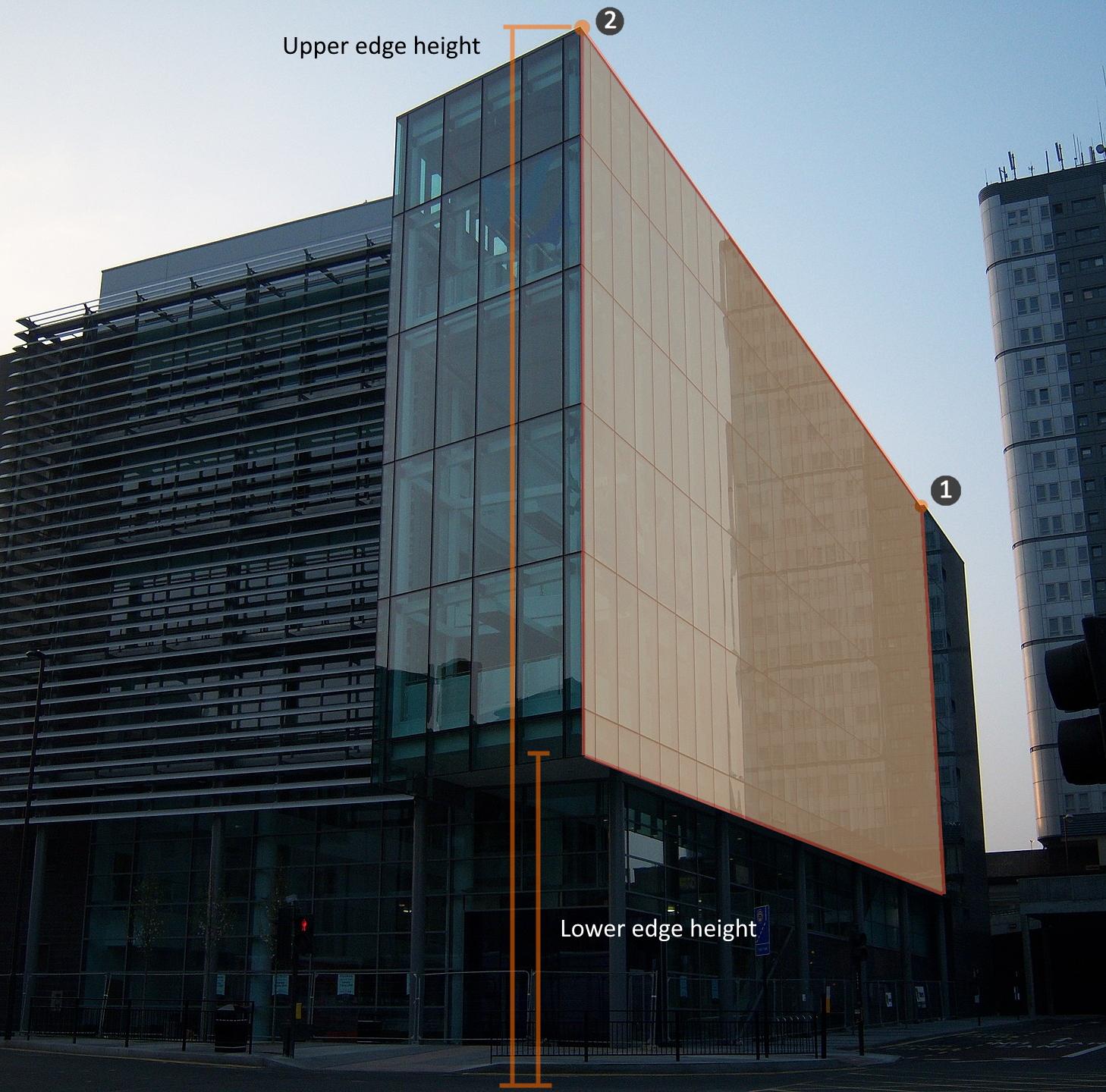
- Slope error (mrad)
- Specifies the amount of scatter that occurs from the surface. Mirror-like surfaces that produce specular reflections will have a slope error closer to zero, while rough surfaces that produce more scattered (diffuse) reflections have higher slope errors. The default RMS slope error of ~10 mrad (which produces a total reflected beam spread of 0.13 rad or 7°) appears to be a reasonable value for glass-like surfaces and is derived from PV module glass coverings.
- Use default smooth glass profile
- Whether the reflectance profile, which defines reflectivity as a function of incidence angle with the sun, should be taken from the PV smooth glass profile. If false, a custom constant reflectivity value may be entered.
- Custom reflectivity
- Constant surface reflectivity value (%) to use for all time-steps.
Receptor Components
Routes, observation points, and flight paths represent receptors which can receive and be impacted by glare.
Route Receptor
The Route receptor is a generic multi-line representation which can simulate observers traveling along continuous paths such as roads, railways, helicopter paths, and multi-segment flight tracks.
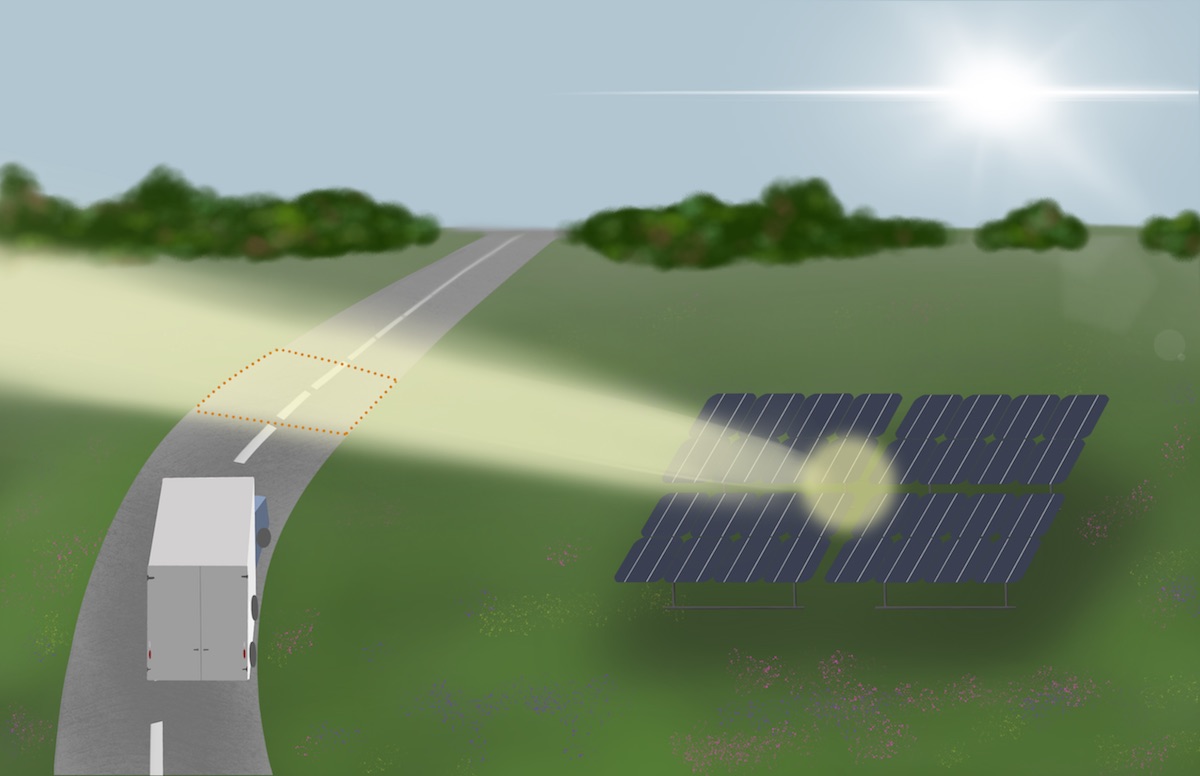
Usage
Routes can be created quickly in the Map Editor:
- Activate the Route drawing mode by clicking the Route button above the map.
- Click once on a location in the map to begin drawing a route
- Click once to add a vertex to the route. Repeat as many times as is necessary; routes can include many line segments
- Double-click on final position to end the Route
- To add a vertex to the Route after it has already been completed, click and drag one of the "ghost" points within the polyline in the map.
Route Parameters
General Route parameters are described below. In addition to these parameters, each Route comprises 2 to 30 vertices which describe its poly-linear representation.
- Name
- Descriptive alphanumeric label of receptor
- Is route one-way?
- If checked, the system will assume observers travel along the route in the direction it was drawn (i.e. order of increasing vertex #). Together with the view angle parameter, this will filter out glare appearing behind the path of travel. If unchecked (default), the system will assume observers travel in both directions.
- Azimuthal view angle (°)
- Describes the horizontal field-of-view (left and right) of observers traveling along the Route. An azimuthal view angle of 180° implies the observer can see visible glare anywhere around them. An azimuthal view angle of 50° (default) implies the observer has a total field-of-view of 100° (50° left and right of their direction of travel). The default value of 50° is derived from FAA research which found that the impact of glare decreases with as its distance from the observer view increases such that glare beyond 50° is mitigated. (Rogers, 2015).
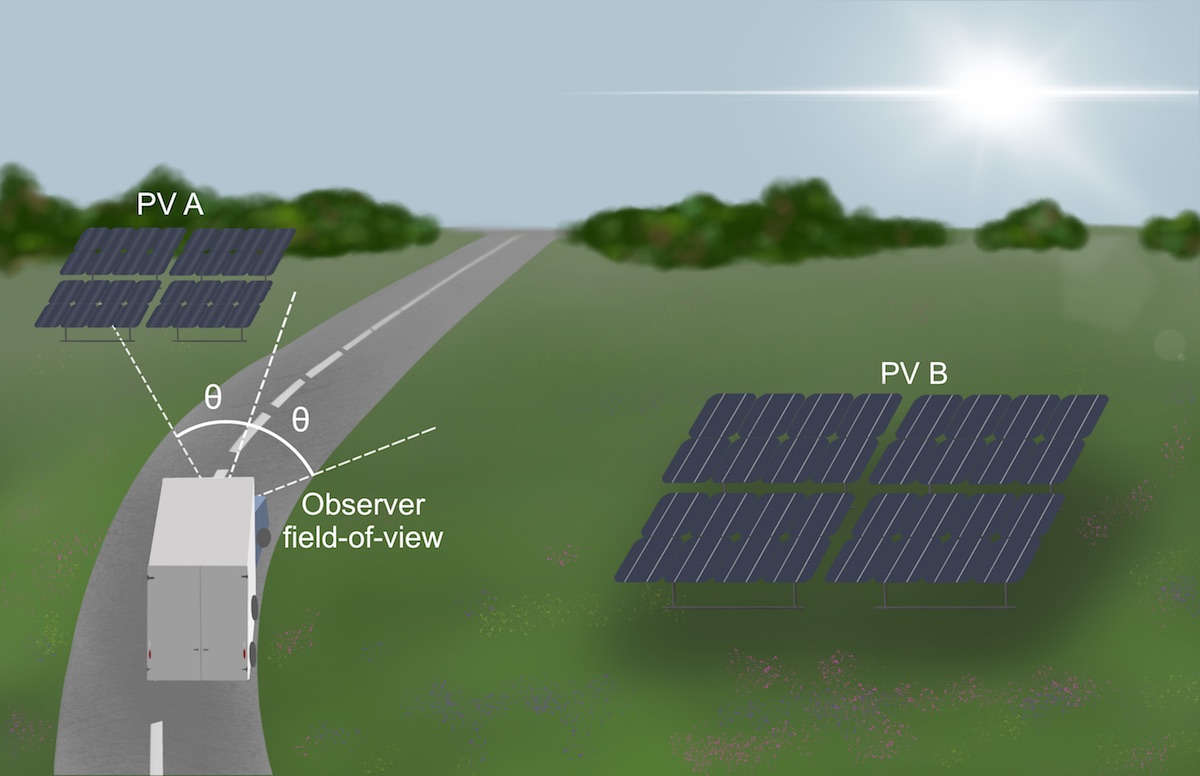
Default azimuthal view angle of 50° yields a total horizontal field-of-view of 100°.
- Downward view angle (°) new
-
Describes the minimum downward viewing angle of the observer utilizing this path (motorist, pilot, rail passenger, etc.).
Glare which is visible at a location below the field-of-view defined by this angle will be ignored.
For example, a Route modeling a custom flight track with a downward view angle of 0° would ignore glare from PV during flight.
The downward view angle is measured down from the direction vector of travel described by the Route vertices (per segment).
To disable this view restriction and include all glare, enter a value of 90°. Conversely, a value of 0° will filter all glare appearing below the Route. The view angle is applied to both directions when modeling a two-way Route.
Examples:Routes created before the downward view angle was implemented have a default value of 90° to match previous behavior.
* Routes modeling motorists or trains will typically have a downward view angle near 0-10° unless they're elevated above nearby terrain.
* Flight tracks may have a downward view angle of 30° (common pilot field-of-view) or 90° (no restriction) because the aircraft is at a high elevation. Refer to the 2-Mile Flight Path receptor view angle parameters for more information on suitable values.
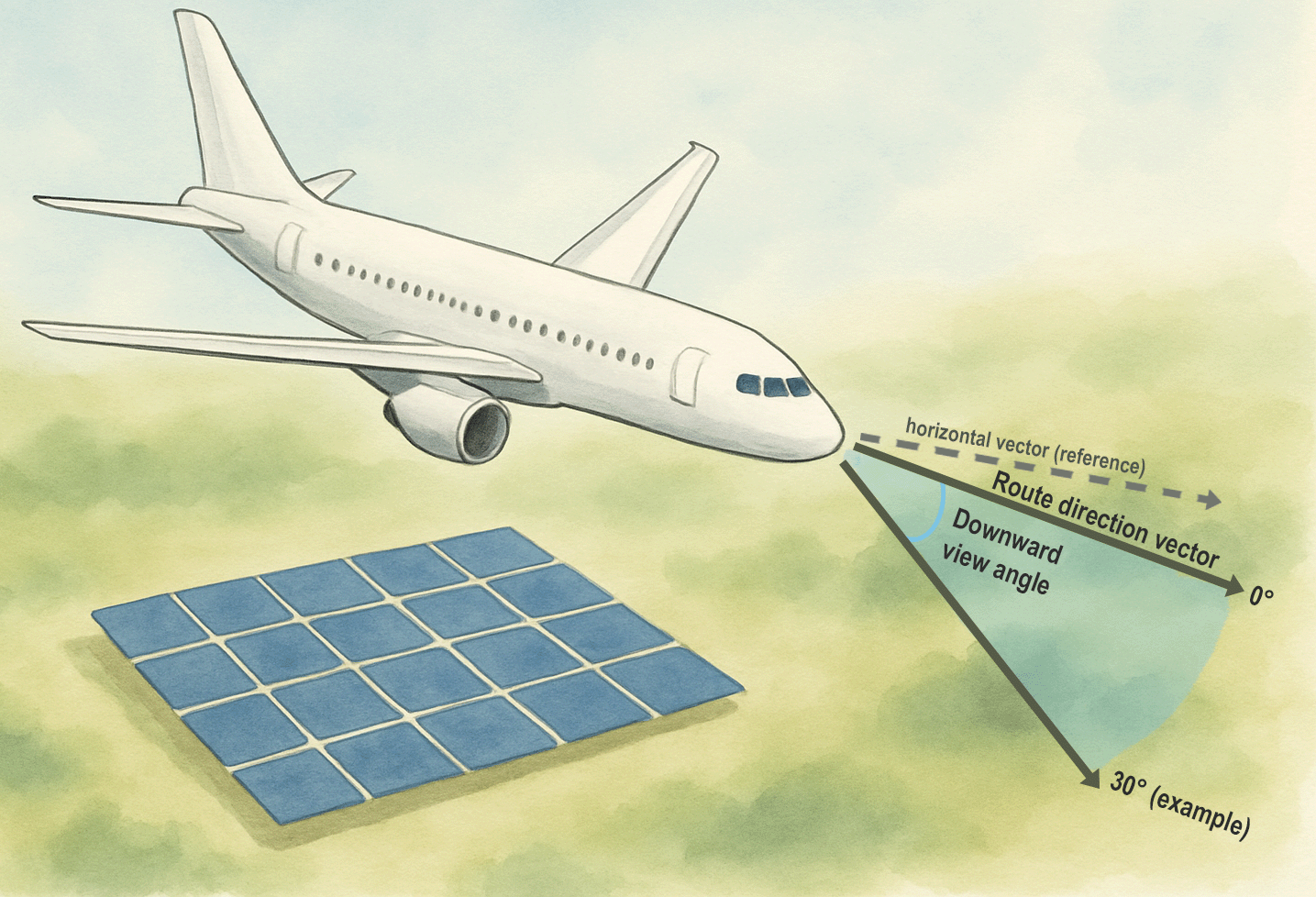
Downward view angle is measured down from receptor direction vector, not from reference flat (horizon) vector.
Observation Point Receptor
The Observation Point receptor ("OP") simulates an observer at a single, discrete location, defined by a latitude, longitude, elevation, and height above ground. In addition, it can be marked to represent an Air Traffic Control Tower ("ATCT") for aviation purposes.
Usage
Follow these steps to create an Observation Point in the map editor:
- Activate the OP drawing mode by clicking the OP button above the map.
- Click once on the desired map location to place an OP at that location.
- Modify location coordinates, including height above ground, in OP data section to right of map. For example, a height of ~5-6 ft. to simulate a stationary observer at ground level.
- To simulate an ATCT, ensure the Is ATCT? checkbox is checked.
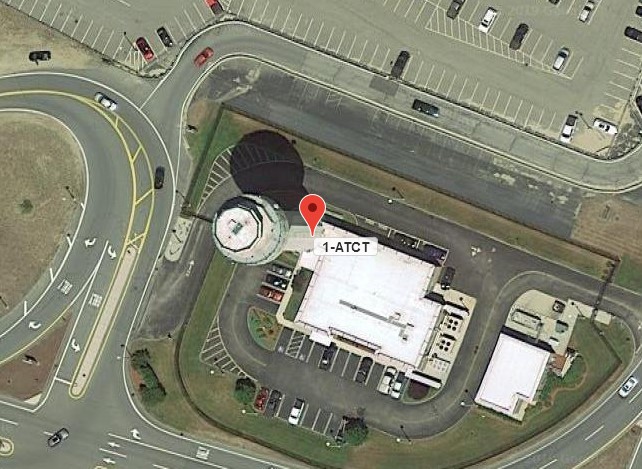
OP Parameters
- Latitude
- Geodetic coordinate defined by WGS-84 datum in decimal degrees with range of -90° to 90°
- Longitude
- Geodetic coordinate defined by WGS-84 datum in decimal degrees with range of -180° to 180°
- Elevation
- Location altitude above sea level. By default, elevation value is provided by Google Elevation service. If marker is moved manually, elevation will be re-queried.
- Height
- Height above ground of observer receptor. Examples: large height for ATCT or 5-6 ft. for person at ground level.
- Is ATCT?
- Check to mark OP as representing an Air Traffic Control Tower. System will review ATCT results for policy adherence when generating aviation PDF.
2-Mile Flight Path Receptor
The 2-Mile Flight Path receptor ("FP") simulates an aircraft following a straight-line approach path toward a runway, by default, including a restricted field-of-view to filter unrealistic glare. In addition, it can be modified to represent a worst-case approach and takeoff path.
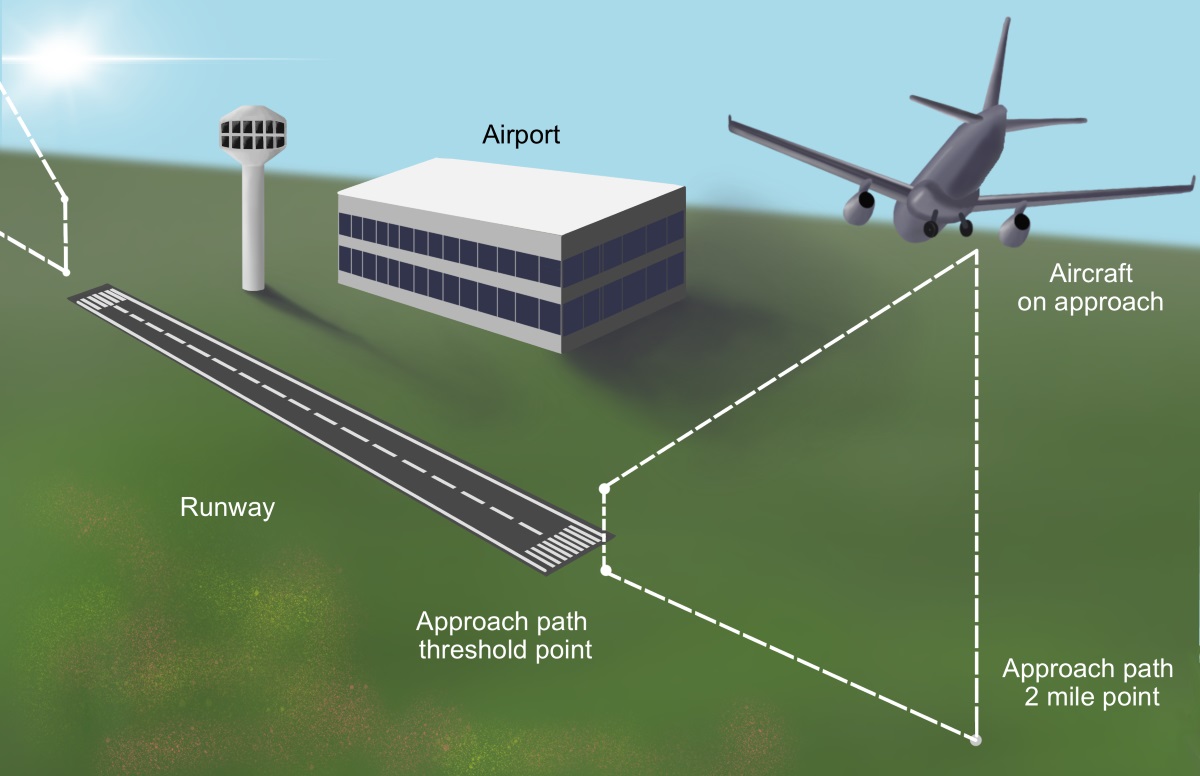
Usage
Follow these steps to create FPs in the map editor:
- Activate the FP drawing mode by clicking the FP button above the map.
- In the map, click once on the runway threshold location to set the FP threshold point. A marker will be placed and a line will extend from the marker to the mouse cursor.
- Click a second time in the direction of the flight path, away from the runway, to set the FP direction. The system will automatically create the 2-mile point in the specified direction.
- Modify the FP glide slope, direction, or elevation values in the FP data section to the right of the map.
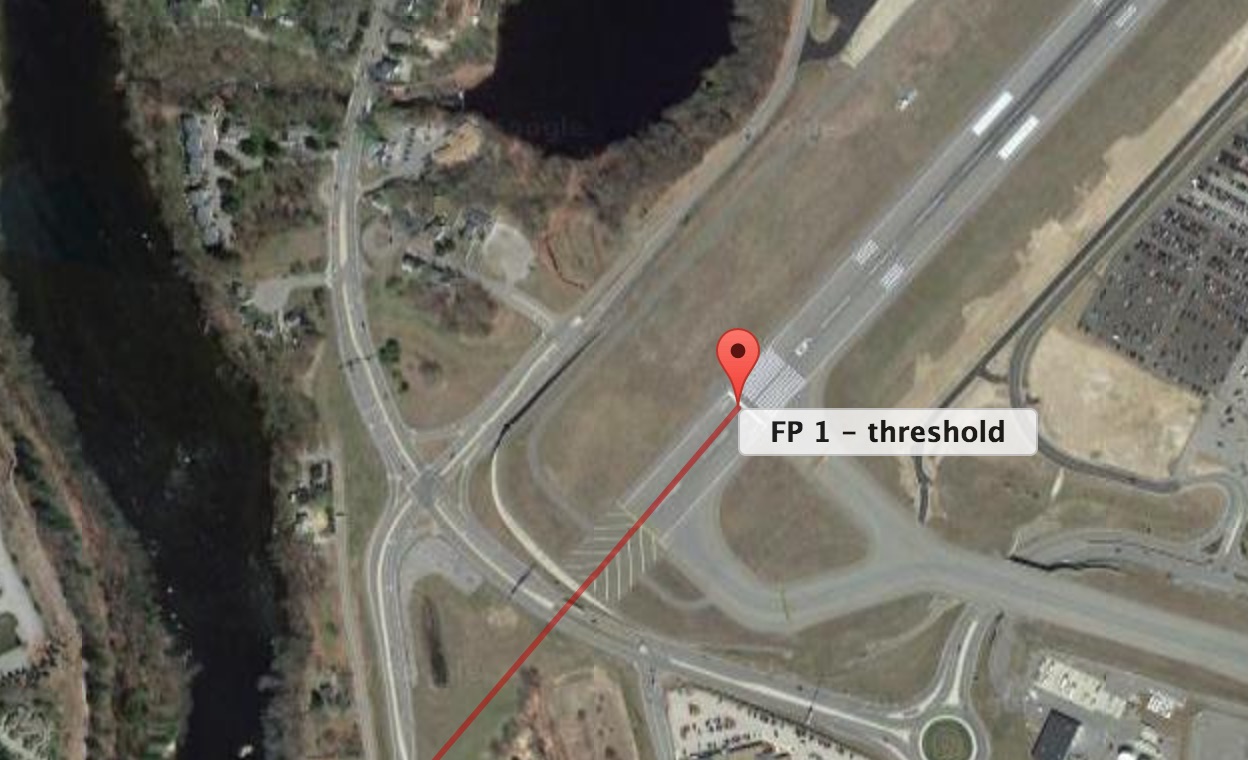
FP Parameters
- Name
- Descriptive alphanumeric label of receptor
- Direction (°)
- Azimuthal angle of approach of aircraft which defines the straight path toward the runway. Measured clockwise from true north.
- Glide slope (°)
- Angle of descent of aircraft toward runway. Default value of 3°.
- Threshold crossing height
- Height above ground of aircraft when it crosses the runway threshold. (Typically 50 ft.).
- Consider pilot field-of-view from cockpit
- if enabled, the analysis will filter glare when it's approximate location is beyond the user-specified
field-of-view ("FOV") parameters during approach.
If disabled, the analysis will apply the maximum FOV: an azimuthal view of 180° and downward view of 180°. (Previously, the V1 analysis methodology filtered glare beyond 50° azimuth and 30° vertical as "lime green" when the pilot FOV consideration was disabled.) - Max downward viewing angle (°)
- The vertical FOV of the pilot, measured positive downward from the approach path vector. Acceptable values are 0° to 90°, where 90° implies no downward restriction. A default value of 30° assumes glare appearing beyond the corresponding FOV is mitigated. (The V1 methodology measured the downward angle from horizontal.)
- Azimuthal viewing angle (°)
- The left and right field-of-view of the pilot during approach. Acceptable values are 0° to 180°. A view angle of 180° implies the pilot can see glare emanating from behind the plane. A view angle of 50° (default) implies the pilot has a FOV of 50° to their left and right during approach, i.e. a total FOV of 100°. This default is based on FAA research which determined that the impact of glare appearing beyond 50° is mitigated (Rogers, 2015).
- Point coordinates
- The threshold and 2-mile point ground elevation parameters can be modified in the FP Advanced dialog. The 2-mile point height is calculated from the point elevations and threshold crossing height to ensure a smooth 2-mile descent path.
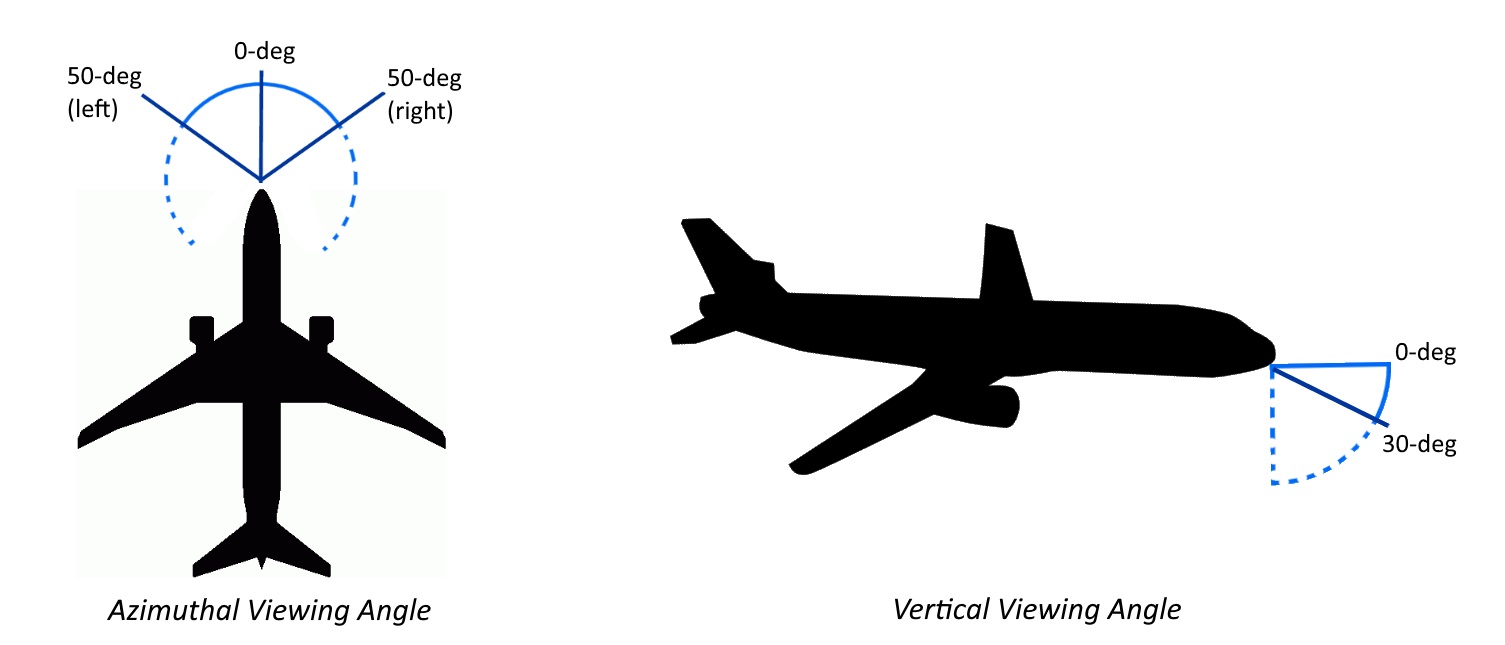
Other Components
Other components which may impact the glare analysis
Obstruction
The Obstruction component simulates obstacles and blocking geometries that may mitigate PV glare. For example, Obstructions can represent tree cover, buildings, and geographic elements.
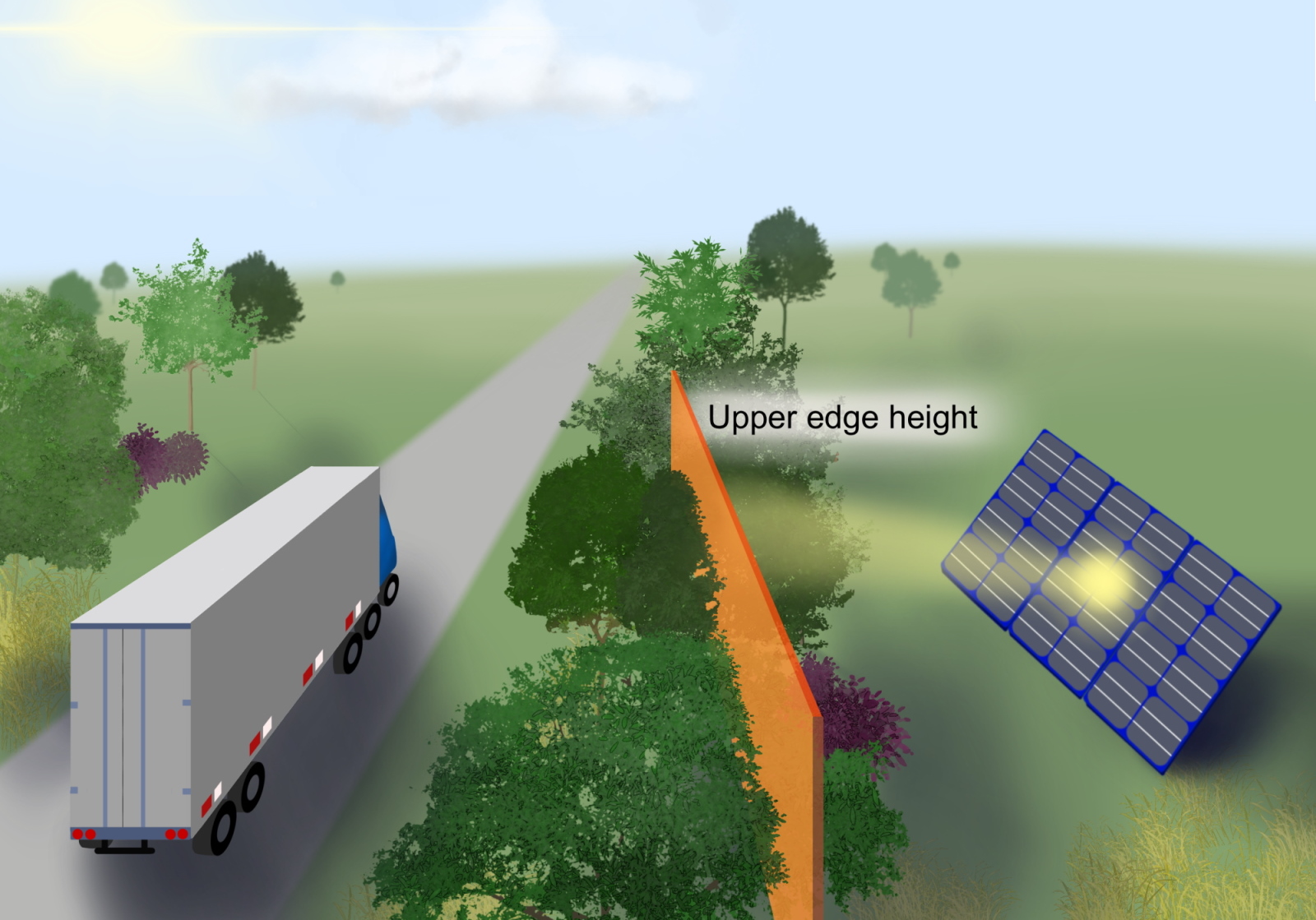
Obstructions are modeled as multi-line paths comprising 2 to 10 vertices. Obstructions may block PV glare reflections from reaching receptors. They may also block incoming sunlight from reaching the reflective surface.
Obstruction segments are modeled as parallelograms with vertical sides that extend upward from the ground. The top "corners" are described by the vertex point elevations and the upper edge height. Obstructions are assumed to be opaque - incoming sunlight and emanating glare reflections are completely mitigated if they intersect the obstruction face.
Obstructions are currently considered in V2 PV glare analyses only.
Usage
Obstructions can be created quickly in the Map Editor:
- Activate the drawing mode by clicking the Obstruction button above the map.
- Click once on a location in the map to begin drawing
- Click once to add a vertex to the Obstruction. Repeat as many times as is necessary; Obstructions can include up to 10 line segments.
- Double-click on final position to end the Obstruction
- To add an additional vertex to the Obstruction after it has already been completed, click and drag one of the "ghost" points within the polyline in the map.
- To remove an existing vertex from an Obstruction, open it's Advanced form and click the delete button next to the vertex in the coordinate table.
Obstruction Parameters
Obstruction parameters are described below. In addition to these parameters, each Obstruction comprises 2 to 10 vertices which describe its poly-linear shape.
- Name
- Descriptive alphanumeric label of component
- Upper edge height
- The height above ground of the top edge of the Obstruction. This height is added to the elevation of each vertex to define it's corresponding upper corner of the face. Note that each Obstruction segment is assumed to be a parallelogram with vertical sides. (i.e. order of increasing vertex #).
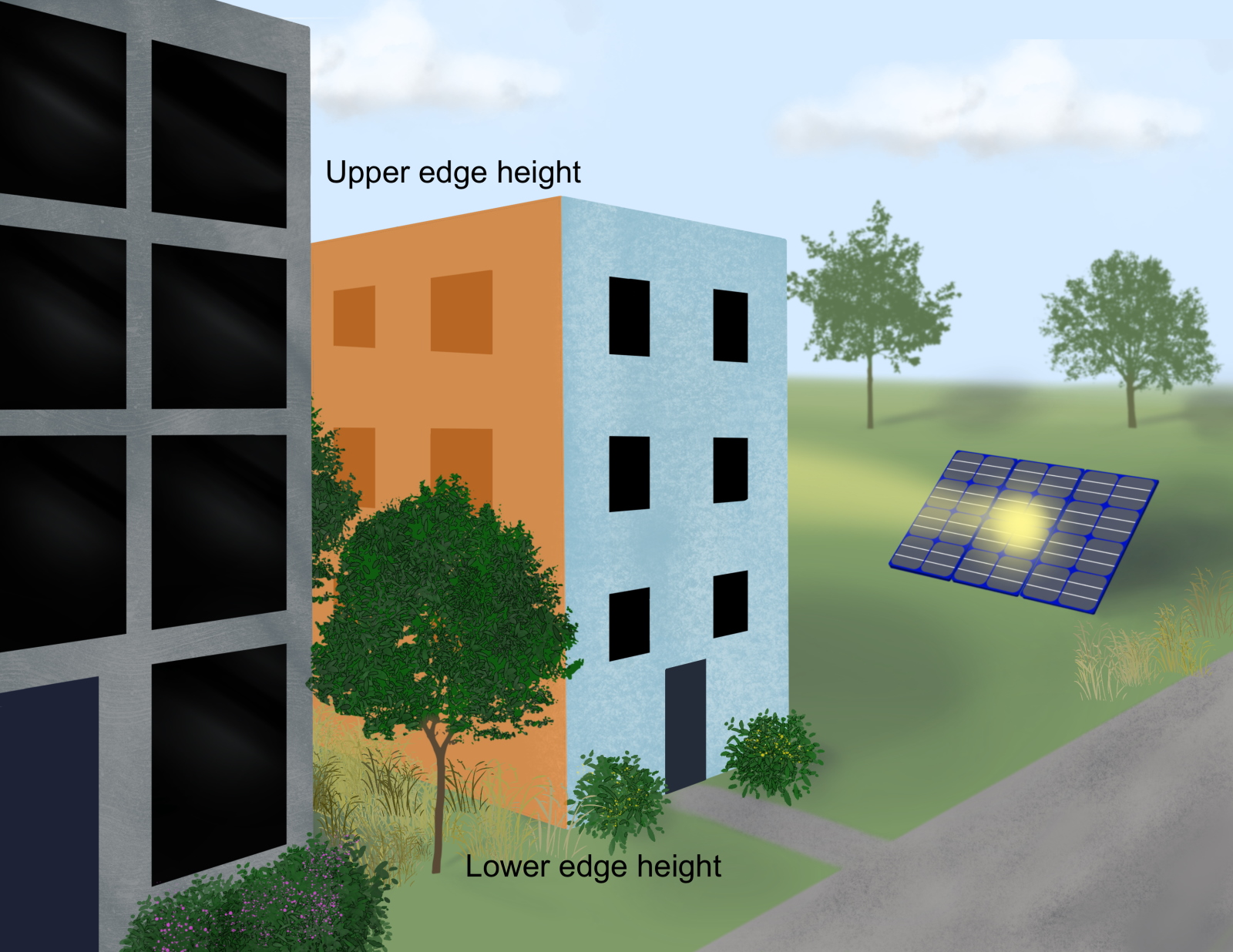
Assumptions & Limitations
Summary of assumptions and abstractions required by the SGHAT/ForgeSolar analysis methodology
- Times associated with glare are denoted in Standard time. For Daylight Savings, add one hour.
- Result data files and plots are retained for two years after analysis completion. Files must be downloaded and saved if additional persistence is required.
- The algorithm does not rigorously represent the detailed geometry of a system; detailed features such as gaps between modules, variable height of the PV array, and support structures may impact actual glare results. However, we have validated our models against several systems, including a PV array causing glare to the air-traffic control tower at Manchester-Boston Regional Airport and several sites in Albuquerque, and the tool accurately predicted the occurrence and intensity of glare at different times and days of the year.
- Several V1 calculations utilize the PV array centroid, rather than the actual glare spot location, due to algorithm limitations. This may affect results for large PV footprints. Additional analyses of array sub-sections can provide additional information on expected glare. This primarily affects V1 analyses of path receptors.
- Random number computations are utilized by various steps of the annual hazard analysis algorithm. Predicted minutes of glare can vary between runs as a result. This limitation primarily affects analyses of Observation Point receptors, including ATCTs. Note that the SGHAT/ForgeSolar methodology has always relied on an analytical, qualitative approach to accurately determine the overall hazard (i.e. green vs. yellow) of expected glare on an annual basis.
- The subtended source angle (glare spot size) is constrained by the PV array footprint size. Partitioning large arrays into smaller sections will reduce the maximum potential subtended angle, potentially impacting results if actual glare spots are larger than the sub-array size. Additional analyses of the combined area of adjacent sub-arrays can provide more information on potential glare hazards. (See previous point on related limitations.)
- The algorithm assumes that the PV array is aligned with a plane defined by the approximate total heights of the PV vertices. For increased accuracy, the user should perform runs using minimum and maximum values for the vertex heights to bound the height of the plane containing the solar array. Doing so will expand the range of observed solar glare when compared to results using a single height value.
- The algorithm does not automatically consider obstacles (either man-made or natural) between the observation points and the prescribed solar installation that may obstruct observed glare, such as trees, hills, buildings, etc.
- The variable direct normal irradiance (DNI) feature (if selected) scales the user-prescribed peak DNI using a typical clear-day irradiance profile. This profile has a lower DNI in the mornings and evenings and a maximum at solar noon. The scaling uses a clear-day irradiance profile based on a normalized time relative to sunrise, solar noon, and sunset, which are prescribed by a sun-position algorithm and the latitude and longitude obtained from Google maps. The actual DNI on any given day can be affected by cloud cover, atmospheric attenuation, and other environmental factors.
- The ocular hazard predicted by the tool depends on a number of environmental, optical, and human factors, which can be uncertain. We provide input fields and typical ranges of values for these factors so that the user can vary these parameters to see if they have an impact on the results. The speed of SGHAT allows expedited sensitivity and parametric analyses.
- The system output calculation is a DNI-based approximation that assumes clear, sunny skies year-round. It should not be used in place of more rigorous modeling methods.
- Hazard zone boundaries shown in the Glare Hazard plot are an approximation and visual aid. Actual ocular impact outcomes encompass a continuous, not discrete, spectrum.
- Glare locations displayed on receptor plots are approximate. Actual glare-spot locations may differ.
References
Additional resources and research on solar glare
-
Ho, C. K., Ghanbari, C. M., and Diver, R. B., 2011, "Methodology to Assess Potential Glint and Glare Hazards From Concentrating Solar Power Plants: Analytical Models and Experimental Validation", ASME J. Sol. Energy Eng., 133. (Download)
-
Federal Aviation Administration (2021). Final Policy, Review of Solar Energy System Projects on Federally Obligated Airports. Document Number 2021-09862. (link)
-
Federal Aviation Administration (2013). Interim Policy, FAA Review of Solar Energy System Projects on Federally Obligated Airports. Federal Register: 63276-63279 (link)
-
Rogers, J. A., et al. (2015). "Evaluation of Glare as a Hazard for General Aviation Pilots on Final Approach", Federal Aviation Administration (Download)
-
Ho, C. K. and Sims, C. A., 2013, "Solar Glare Hazard Analysis Tool (SGHAT) User's Manual v. 3.0". (Download)
-
Ho, C. K., Sims, C. A., Yellowhair, J. E. and Bush, H. E., 2014, "Solar Glare Hazard Analysis Tool (SGHAT) Technical Reference Manual", SAND2014-18360 O, Sandia National Laboratories, Albuquerque, NM. (Download)
-
Overview presentation of the Solar Glare Hazard Analysis Tool (SGHAT) (Download)
-
Ho, C. K., April 2013, "Relieving a Glaring Problem", Solar Today Magazine (Download)
-
Barrett, S., June 2013, "Glare Factor: Solar Installations And Airports", Solar Industry, Volume 6, Number 5. (link)
-
Ho, C. K., 2012, "Glare Impacts from Solar Power Plants near Airports", in Proceedings of ACC/AAAE Airport Planning, Design and Construction Symposium, Denver, Colorado, Feb. 29 - Mar. 2. (Download)
-
Ho, C. K., 2011, "Observations and Assessments of Glare from Heliostats and Trough Collectors: Helicopter Flyover and Drive-By Sightings", in proceedings of SolarPACES 2011, Granada, Spain, Sept. 20-23. (Download)
-
Ho, C. K., 2011, "Summary of Impact Analyses of Renewable Energy Technologies on Aviation and Airports", Presentation to Federal Aviation Administration, Feb. 16. (Download)
-
Ho, C. K., Ghanbari, C. M., and Diver, R. B., 2010, "Methodology to Assess Potential Glint and Glare Hazards From Concentrating Solar Power Plants: Analytical Models and Experimental Validation", SAND2010-2581C, in proceedings of the 4th International Conference on Energy Sustainability, Phoenix, AZ, May 17-22. (Download)
-
Ho, C. K. and Khalsa, S. S., 2010, "Hazard Analysis and Web-Based Tool for Evaluating Glint and Glare from Solar Collector Systems", in proceedings of SolarPACES 2010, Perpignan, France, Sept. 21-24. (Paper) (Presentation)
-
Ho, C. K., Ghanbari, C. M., and Diver, R. B., 2009, "Hazard Analyses of Glint and Glare From Concentrating Solar Power Plants", SAND2009-4131C, in proceedings of SolarPACES 2009, Berlin, Germany, Sept. 15-18. (Download)
-
Yellowhair, J. and C.K. Ho. "Assessment of Photovoltaic Surface Texturing on Transmittance Effects and Glint/Glare Impacts". ASME 2015 9th International Conference on Energy Sustainability collocated with the ASME 2015 Power Conference, the ASME 2015 13th International Conference on Fuel Cell Science, Engineering and Technology, and the ASME 2015 Nuclear Forum. 2015. American Society of Mechanical Engineers. (PDF)
-
Sliney, D.H. and B.C. Freasier, 1973, "Evaluation of Optical Radiation Hazards", Applied Optics, 12(1), p. 1-24.
-
Anderson, K. and M. Mikofski, 2020, "Slope-Aware Backtracking for Single-Axis Trackers." Golden, CO. National Renewable Energy Laboratory. NREL/TP-5K00-76626. https://www.nrel.gov/docs/fy20osti/76626.pdf
-
Lorenzo, E., L. Narvarte and J. Munoz, 2011, "Tracking and back-tracking." Madrid, Spain. Progress in Photovoltaics: Research and Applications 19: 747-753. https://doi.org/10.1002/pip.1085
Release Notes
Summary of updates and changes
Analysis results may change between releases as updates and enhancements are developed. Always save/download analysis results upon analysis completion.
Upcoming Enhancements
Features planned/considered for upcoming releases. This list is subject to change and does not guarantee future availability.
- Expand contents of analysis data file.
- Expand optimization results.
Release 2025C
- Route receptors now have an optional downward view angle parameter in additional to the azimuthal view angle restriction.
- The Optimization tool now includes additional hazard grid results based on FAA policy.
- The Result Data File now includes panel rotation vector data when using tracking PV.
- Vertical Surface analysis results now include additional result plots like flight path and luminance charts.
- The Optimization results print formatting has been updated.
Release 2025B
- Increased maximum number of Observation Points per analysis in Basic projects (20->40) and Advanced projects (40->60)
- Increased maximum number of Obstructions per analysis in all projects (10->20)
- Increased maximum number of Flight Paths per analysis in Basic projects (10->20)
- Added Luminance section to Help page
- Various cosmetic enhancements to analysis editor
Note that component increases apply to projects created after the release date of the 2025B Update.
Release 2025A
- Site configurations (and their analysis results) which have been accidentally deleted can now be restored by the admin upon request.
- The default PV backtracking option is now "shade" (instead of "shade-slope") to better match typical industry usage.
In addition to these changes, the following editor-specific Improvements have been released:
- Added "height override" fields to quickly fill in identical values for vertex parameters (e.g. all heights)
- Added buttons in each component Advanced view to easily delete selected vertices from the component
- Right-clicking no longer deletes multi-point components in the map (we, too, have done this too many times!)
- Updated the component data section layout to be more responsive
Release 2024B
- Vertical Surface glare analyses can now compute per-minute luminance values
- Vertical Surface glare analyses can now generate an analysis data file
- The Vertical Surface section of the site analysis results page has been updated
- The FAQ has been updated
Release 2024A
- New billing portal for streamlined subscription and payment management
- Simplified process for adding company billing details including tax IDs
- Updated Terms of Use and Privacy Policy to reflect billing portal changes
Release 2023C.1
- Improve Obstruction functionality regarding discontinuities
Release 2023C
- Add-on purchase invoices can now be downloaded from the Invoices page
- Various analysis improvements to glare filtering and luminance data displays.
- The component toolbuttons are now accessible when the map is in full-screen mode.
- Map labels can now be toggled on and off in both map modes.
Release 2023B
New sun altitude threshold input, enhanced luminance calculations, and improved Obstruction accuracy.
- Expanded luminance assessment can now be activated via the site configuration settings. When active, the luminance assessment will include peak luminance data and charts for each PV array and receptor.
- A Sun altitude threshold can be entered via the site settings form in the editor. This threshold filters out glare occurring when the sun is below the inputted altitude angle.
- Obstruction filtering has been improved regarding per-segment occlusion, primarily on route sections.
Release 2023A
This release comprises various backend and content updates, enhancements, and fixes.
- Client name can now be changed in Project Edit Form if no analyses have been conducted yet
Release 2022C
- The new Obstruction component is now available! Use Obstructions to model blocking elements that mitigate sunlight and glare such as tree cover, screening, and buildings.
- The impact of PV footprint polygon "concavity filling" has been substantially reduced.
- The subtended source angle calculation is now more accurate regarding the effective glare-spot size. This enhancement can be disabled to duplicate previous results by unchecking the Use enhanced subtended source angle option in the site settings menu within the editor.
- Individual vertices in Obstructions and Vertical Surfaces can now be removed via the Advanced dialog in the editor.
- The map editor now displays component information while creating new components. Displayed info includes the number of committed vertices, the length of the component, and the length of the current segment.
- Due to analysis limitations, components now have a limit on the number of vertices they may comprise.
Release 2022B
- A generic analysis report document PDF can now be downloaded from the site results page. (Read more about report options here.)
- An aviation report PDF themed for the U.S. FAA 2021 policy update can be downloaded from the site results page.
- A site name can now be entered directly when importing a new site via XLS.
- 2-mile FP threshold point latitude and longitude coordinates can now edited after the FP is created.
- The component data file is now generated via the file delivery system to avoid browser timeouts.
- Vertical Surface vertex coordinates are now editable.
Release 2022A
- Add several time-based methods for simulating backtracking strategies for single-axis tracking PV.
- Add sample backtracking data and plots to site data export.
- Add luminance data to analysis data file (beta feature).
- Specify analysis methodology in aviation report.
- Specify additional backtracking parameters in aviation report.
- Various bug fixes.
Release 2021A.1
- Implement more durable PDF generation with emailed download link.
- Add analysis demo video.
Release 2021A
The 2021A "V2" Release contains substantial updates to accounts, projects, and analysis methodologies. See the 2021A Update page for more information.
- Revamp projects with tiering and per-project tool limits.
- Implement enhanced "Version 2" point and path analysis methodologies.
- Implement new Data Access Subscription plan for maintaining view access to existing projects.
- Add tabular display of temporal (distinct) glare data filtered by month and hour.
- Add new heatmap visualization for approximating section(s) of path receiving glare.
- Begin using simplified release naming scheme.
Release 2020.05
- Restore original column ordering in analysis XLS data file and add panel glancing angle column.
- Enhance error handling and display.
- Increase analysis timeout duration.
Release 2020.04
Improved analysis handling
- Server upgrades! Server capacity, including analysis processing, has been upgraded.
- Email notification system for long-running analyses.
- Email notifications are automatically activated when an analysis takes longer than the timeout limit.
- In-progress analyses can now be canceled from the progress dialog.
Data File Export Update
Analysis data files are now in XLS format and contain all results for a specified PV array. Data file creation is now off by default, and can be enabled in the editor via the site settings (Site Configuration -> Settings).
Methodology Update Prep
Various enhancements have been implemented to prepare for upcoming glare analysis methodology improvements.
Misc. Updates
- Improved error messages during XLS uploads
- Expanded Help page content, including data file descriptions
- Numerous behind-the-scenes backend and testing improvements
Release 2019.06
- Various updates to Help page
- Numerous improvements and updates to server, queuing, and backend functionality
Release 2019.03
- Add Help page
- Various backend and server improvements
- Update free demo features
- Update upcoming subscription notification functionality
Release 2019.01
- Add cookie consent banner
- Add Invoices page under Account to view past invoices
Release 2018.11
New Route Receptor
Glare analyses can now utilize a generic route receptor to model continuous, multi-segment paths. Use routes to model receptors for roads, rail lines, helicopter paths and other multiline features.
Other Changes
- Updated Terms of Service and Privacy Policy to clarify subscription terms and accommodate GDPR
- Rename the flight path receptor to "2-mile flight path" for clarity
- Miscellaneous bug fixes and improvements
Release 2018.05/06/07
- Update error handling during analyses
- Update pricing and Glare Review pages
- Misc. bug fixes
Release 2018.04
Various Vertical Surfaces Updates
- Polish display of VS results
- Allow export of VS data
Release 2018.03
Methodology Updates
- Various improvements to accuracy and reliability of OP backward ray-tracing "scatter-point" glare check algorithm
- Various improvements to accuracy of sun scatter factor in path glare check algorithm
- Improve accuracy of glare impact calculations based on glare spot location
ForgeSolar is dedicated to providing the latest technology in glare analysis. Point and path glare analysis methods have been updated to provide even greater accuracy. These changes represent advancements in the study of PV glare. Future analyses may yield different results than prior analyses. Note that prior results will not change unless the analysis is re-run.
Release 2017.11
Aviation PDF
Added aviation-pertinent PDF summarizing glare analysis results for typical aviation requirements
Other updates
- Export component data to XLSX
- Upload KML with PV arrays (Beta)
- Mark OPs as ATCT for tailored results
Release 2017.06
OP Glare Spot Plot
Added plot displaying approximate locations of predicted glare spot centers (reflections) on PV array
Release 2017.04
- Module slope error is now based on selected PV module material by default
- PV systems with single-axis tracking now default to a max rotation angle of 60 deg
- Flight paths now limit pilot view to reasonable values by default. (This is acceptable to FAA).
- Analysis results now include a stacked column chart displaying number of minutes of glare per day.
Release 2016.12
- Upgrade server capacity and queuing system
- Updates to GlaReduce Optimization tool
Release 2016.06
- Move to forgesolar.com domain
- Update FAQ
- Numerous bug fixes
Release 2016.05
- Add component data to results page
Release 2016.04
- Increase max number of concurrent glare analyses
- Add Help pages
- Due to their impact on disk usage, PV Optimization analyses no longer create .CSV data files
About Us
ForgeSolar includes GlareGauge, the leading solar glare analysis tool used globally every day to satisfy local standards and policies. ForgeSolar is based on the Solar Glare Hazard Analysis Tool ("SGHAT") licensed from Sandia National Laboratories.
Useful Links
Contact Info
6077 Far Hills Ave. #101,
Centerville, Ohio 45459